On the Increasing Importance of Air-Sea Exchanges in a Thawing Arctic: A Review
Abstract
:1. Introduction
2. Background
2.1. Theory of Surface Turbulent Fluxes
2.2. Sensitivities of Surface Turbulent Fluxes
2.3. Arctic Ocean Surface Turbulent Flux Data Sets
2.3.1. In Situ Measurements
2.3.2. Meteorological Reanalysis Datasets
2.3.3. Satellite Data
2.4. Interaction and Feedbacks of Turbulent Fluxes with Components of the Arctic Climate System
2.4.1. Sea Ice
2.4.2. Atmospheric Circulation
2.4.3. Clouds
2.4.4. Ocean Heat Transport, Variability, and Mixed-Layer Processes
3. Current Understanding
3.1. Mean State and Seasonal Cycle: Satellite Retrievals and Models
3.2. Multiple Timescale Drivers of Variability: Magnitude and Controls of Variation
3.3. Surface Turbulent Flux Trends
4. Projected Changes in Arctic Sensible and Latent Heat Fluxes
4.1. Domain-Averaged and Regional Changes
4.2. Relationship between Surface Turbulent Fluxes and Arctic Amplification
5. Conclusions, Discussion, and Future Direction
Acknowledgments
Author Contributions
Conflicts of Interest
References
- Zhang, C. Madden-Julian Oscillation. Rev. Geophys. 2005, 43, RG2003. [Google Scholar] [CrossRef]
- Sobel, A.H.; Maloney, E.D.; Bellon, G.; Frierson, D.M. The role of surface heat fluxes in tropical intraseasonal oscillations. Nat. Geosci. 2008, 1, 653–657. [Google Scholar] [CrossRef]
- Sobel, A.H.; Maloney, E.D.; Bellon, G.; Frierson, D.M. Surface Fluxes and Tropical Intraseasonal Variability: A Reassessment. J. Adv. Model. Earth Syst. 2010, 2, 2. [Google Scholar] [CrossRef]
- Tromeur, E.; Rossow, W.B. Interaction of Tropical Deep Convection with the Large-Scale Circulation in the MJO. J. Clim. 2010, 23, 1837–1853. [Google Scholar] [CrossRef]
- Føre, I.; Kristjánsson, J.E.; Kolstad, E.W.; Bracegirdle, T.J.; Saetra, Ø.; Røsting, B. A ‘hurricane-like’ polar low fuelled by sensible heat flux: High-resolution numerical simulations. Q. J. R. Meteorol. Soc. 2012, 138, 1308–1324. [Google Scholar] [CrossRef] [Green Version]
- Hartmann, D. Global Physical Climatology; International Geophysics Series; Academic Press: San Diego, CA, USA, 1994; Volume 56, ISBN 0-12-328530-5. [Google Scholar]
- Bourassa, M.A.; Gille, S.T.; Bitz, C.; Carlson, D.; Cerovecki, I.; Clayson, C.A.; Cronin, M.F.; Drennan, W.M.; Fairall, C.W.; Hoffman, R.N.; et al. High-Latitude Ocean and Sea Ice Surface Fluxes: Challenges for Climate Research. Bull. Am. Meteorol. Soc. 2013, 94, 403–423. [Google Scholar] [CrossRef] [Green Version]
- Boeke, R.C.; Taylor, P.C. Evaluation of the Arctic surface radiation budget in CMIP5 models. J. Geophys. Res. Atmos. 2016, 121. [Google Scholar] [CrossRef]
- Nilsson, E.D.; Rannik, Ü.; Swietlicki, E.; Leck, C.; Aalto, P.P.; Zhou, J.; Norman, M. Turbulent aerosol fluxes over the Arctic Ocean: 2. Wind-driven sources from the sea. J. Geophys. Res. Atmos. 2001, 106, 32139–32154. [Google Scholar] [CrossRef]
- Persson, P.O.G.; Fairall, C.W.; Andreas, E.L.; Guest, P.S.; Perovich, D.K. Measurements near the Atmospheric Surface Flux Group tower at SHEBA: Near-surface conditions and surface energy budget. J. Geophys. Res. Oceans 2002, 107, 8045. [Google Scholar] [CrossRef]
- Miller, N.B.; Shupe, M.D.; Cox, C.J.; Noone, D.; Persson, P.O.G.; Steffen, K. Surface energy budget responses to radiative forcing at Summit, Greenland. Cryosphere 2017, 11, 497–516. [Google Scholar] [CrossRef]
- Schweiger, A.J.; Lindsay, R.W.; Vavrus, S.; Francis, J.A. Relationships between Arctic Sea Ice and Clouds during Autumn. J. Clim. 2008, 21, 4799–4810. [Google Scholar] [CrossRef]
- Kay, J.E.; Gettelman, A. Cloud influence on and response to seasonal Arctic sea ice loss. J. Geophys. Res. Atmos. 2009, 114, D18204. [Google Scholar] [CrossRef]
- McFarquhar, G.M.; Ghan, S.; Verlinde, J.; Korolev, A.; Strapp, J.W.; Schmid, B.; Tomlinson, J.M.; Wolde, M.; Brooks, S.D.; Cziczo, D.; et al. Indirect and Semi-direct Aerosol Campaign. Bull. Am. Meteorol. Soc. 2010, 92, 183–201. [Google Scholar] [CrossRef]
- Barton, N.P.; Klein, S.A.; Boyle, J.S.; Zhang, Y.Y. Arctic synoptic regimes: Comparing domain-wide Arctic cloud observations with CAM4 and CAM5 during similar dynamics. J. Geophys. Res. Atmos. 2012, 117. [Google Scholar] [CrossRef]
- Sato, K.; Inoue, J.; Kodama, Y.-M.; Overland, J.E. Impact of Arctic sea-ice retreat on the recent change in cloud-base height during autumn. Geophys. Res. Lett. 2012, 39, L10503. [Google Scholar] [CrossRef]
- Taylor, P.C.; Kato, S.; Xu, K.-M.; Cai, M. Covariance between Arctic sea ice and clouds within atmospheric state regimes at the satellite footprint level. J. Geophys. Res. Atmos. 2015, 120, 12656–12678. [Google Scholar] [CrossRef] [PubMed]
- Bintanja, R.; Graversen, R.G.; Hazeleger, W. Arctic winter warming amplified by the thermal inversion and consequent low infrared cooling to space. Nat. Geosci. 2011, 4, 758–761. [Google Scholar] [CrossRef]
- Pavelsky, T.M.; Boé, J.; Hall, A.; Fetzer, E.J. Atmospheric inversion strength over polar oceans in winter regulated by sea ice. Clim. Dyn. 2011, 36, 945–955. [Google Scholar] [CrossRef]
- Cohen, J.; Screen, J.A.; Furtado, J.C.; Barlow, M.; Whittleston, D.; Coumou, D.; Francis, J.; Dethloff, K.; Entekhabi, D.; Overland, J.; et al. Recent Arctic amplification and extreme mid-latitude weather. Nat. Geosci. 2014, 7, 627–637. [Google Scholar] [CrossRef] [Green Version]
- Overland, J.E.; Dethloff, K.; Francis, J.A.; Hall, R.J.; Hanna, E.; Kim, S.-J.; Screen, J.A.; Shepherd, T.G.; Vihma, T. Nonlinear response of mid-latitude weather to the changing Arctic. Nat. Clim. Chang. 2016, 6, 992–999. [Google Scholar] [CrossRef]
- Serreze, M.; Barry, R.G. The Arctic Climate System, 2nd ed.; Cambridge University Press: New York, NY, USA, 2014; ISBN 978-1-139-58381-7. [Google Scholar]
- ACIA. Arctic Climate Impact Assessment; ACIA Overview Report; AMAP: Oslo, Norway, 2004. [Google Scholar]
- Chylek, P.; Folland, C.K.; Lesins, G.; Dubey, M.K.; Wang, M. Arctic air temperature change amplification and the Atlantic Multidecadal Oscillation. Geophys. Res. Lett. 2009, 36, L14801. [Google Scholar] [CrossRef]
- Hartmann, D.L.; Tank, A.M.; Rusticucci, M.; Alexander, L.V.; Brönnimann, S.; Charabi, Y.A.; Dentener, F.J.; Dlugokencky, E.J.; Easterling, D.R.; Kaplan, A.; et al. Observations: Atmopshere and Surface. In Climate Change 2013: The Physical Science Basis; Contribution of Working Group I to the Fifth Assessment Report of the Intergovernmental Panel on climate Chnage; Cambridge University Press: Cambridge, UK, 2013. [Google Scholar]
- Comiso, J.C.; Hall, D.K. Climate trends in the Arctic as observed from space. Wiley Interdiscip. Rev. Clim. Chang. 2014, 5, 389–409. [Google Scholar] [CrossRef] [PubMed]
- Stroeve, J.C.; Serreze, M.C.; Holland, M.M.; Kay, J.E.; Malanik, J.; Barrett, A.P. The Arctic’s rapidly shrinking sea ice cover: A research synthesis. Clim. Chang. 2012, 110, 1005–1027. [Google Scholar] [CrossRef]
- Knies, J.; Cabedo-Sanz, P.; Belt, S.T.; Baranwal, S.; Fietz, S.; Rosell-Melé, A. The emergence of modern sea ice cover in the Arctic Ocean. Nat. Commun. 2014, 5. [Google Scholar] [CrossRef] [PubMed]
- Snape, T.J.; Forster, P.M. Decline of Arctic sea ice: Evaluation and weighting of CMIP5 projections. J. Geophys. Res. Atmos. 2014, 119. [Google Scholar] [CrossRef]
- Wang, M.; Overland, J.E. A sea ice free summer Arctic within 30 years: An update from CMIP5 models. Geophys. Res. Lett. 2012, 39. [Google Scholar] [CrossRef]
- Taylor, P.C.; Maslowski, W.; Perlwitz, J.; Wuebbles, D.J. Arctic changes and their effects on Alaska and the rest of the United States. In Climate Science Special Report: Fourth National Climate Assessment; Wuebbles, D.J., Fahey, D.W., Hibbard, K.A., Dokken, D.J., Stewart, B.C., Maycock, T.K., Eds.; U.S. Global Change Research Program: Washington, DC, USA, 2017; Volume I, pp. 303–332. [Google Scholar]
- AMAP. Arctic Climate Issues 2011: Changes in Arctic Snow, Water, Ice and Permafrost | AMAP; AMAP: Oslo, Norway, 2012; p. 97. [Google Scholar]
- Myers-Smith, I.H.; Forbes, B.C.; Wilmking, M.; Hallinger, M.; Lantz, T.; Blok, D.; Tape, K.D.; Macias-Fauria, M.; Sass-Klaassen, U.; Lévesque, E.; et al. Shrub expansion in tundra ecosystems: Dynamics, impacts and research priorities. Environ. Res. Lett. 2011, 6, 045509. [Google Scholar] [CrossRef]
- Vaughan, D.G.; Comiso, J.C. Observations: Cryosphere. In Climate Change 2013: The Physical Science Basis. Contribution of Working Group I to the Fifth Assessment Report of the Intergovernmental Panel on Climate Change; Cambridge University Press: Cambridge, UK, 2013. [Google Scholar]
- Koven, C.D.; Lawrence, D.M.; Riley, W.J. Permafrost carbon–climate feedback is sensitive to deep soil carbon decomposability but not deep soil nitrogen dynamics. Proc. Natl. Acad. Sci. USA 2015, 112, 3752–3757. [Google Scholar] [CrossRef] [PubMed]
- Zemp, M.; Frey, H.; Gärtner-Roer, I.; Nussbaumer, S.U.; Hoelzle, M.; Paul, F.; Haeberli, W.; Denzinger, F.; Ahlstrøm, A.P.; Anderson, B.; et al. Historically unprecedented global glacier decline in the early 21st century. J. Glaciol. 2015, 61, 745–762. [Google Scholar] [CrossRef]
- Harig, C.; Simons, F.J. Ice mass loss in Greenland, the Gulf of Alaska, and the Canadian Archipelago: Seasonal cycles and decadal trends. Geophys. Res. Lett. 2016, 43, 2016GL067759. [Google Scholar] [CrossRef]
- Boisvert, L.N.; Stroeve, J.C. The Arctic is becoming warmer and wetter as revealed by the Atmospheric Infrared Sounder. Geophys. Res. Lett. 2015, 42, 2015GL063775. [Google Scholar] [CrossRef]
- Boisvert, L.N.; Wu, D.L.; Shie, C.-L. Increasing evaporation amounts seen in the Arctic between 2003 and 2013 from AIRS data. J. Geophys. Res. Atmos. 2015, 120, 2015JD023258. [Google Scholar] [CrossRef]
- Markus, T.; Stroeve, J.C.; Miller, J. Recent changes in Arctic sea ice melt onset, freezeup, and melt season length. J. Geophys. Res. Oceans 2009, 114, C12024. [Google Scholar] [CrossRef]
- Stroeve, J.C.; Markus, T.; Boisvert, L.; Miller, J.; Barrett, A. Changes in Arctic melt season and implications for sea ice loss. Geophys. Res. Lett. 2014, 41, 2013GL058951. [Google Scholar] [CrossRef]
- Stroeve, J.; Notz, D. Insights on past and future sea-ice evolution from combining observations and models. Glob. Planet. Chang. 2015, 135, 119–132. [Google Scholar] [CrossRef]
- Rinke, A.; Maslowski, W.; Dethloff, K.; Clement, J. Influence of sea ice on the atmosphere: A study with an Arctic atmospheric regional climate model. J. Geophys. Res. Atmos. 2006, 111, D16103. [Google Scholar] [CrossRef]
- Francis, J.A.; Chan, W.; Leathers, D.J.; Miller, J.R.; Veron, D.E. Winter Northern Hemisphere weather patterns remember summer Arctic sea-ice extent. Geophys. Res. Lett. 2009, 36, L07503. [Google Scholar] [CrossRef]
- Serreze, M.C.; Barrett, A.P.; Stroeve, J.C.; Kindig, D.N.; Holland, M.M. The emergence of surface-based Arctic amplification. Cryosphere 2009, 3, 11–19. [Google Scholar] [CrossRef]
- Screen, J.A.; Simmonds, I. Increasing fall-winter energy loss from the Arctic Ocean and its role in Arctic temperature amplification. Geophys. Res. Lett. 2010, 37, L16707. [Google Scholar] [CrossRef]
- Overland, J.E.; Wang, M. Large-scale atmospheric circulation changes are associated with the recent loss of Arctic sea ice. Tellus A 2010, 62, 1–9. [Google Scholar] [CrossRef]
- Vihma, T. Effects of Arctic Sea Ice Decline on Weather and Climate: A Review. Surv. Geophys. 2014, 35, 1175–1214. [Google Scholar] [CrossRef]
- Parkinson, C.L. Spatially mapped reductions in the length of the Arctic sea ice season. Geophys. Res. Lett. 2014, 41, 2014GL060434. [Google Scholar] [CrossRef] [PubMed]
- Thomson, J.; Fan, Y.; Stammerjohn, S.; Stopa, J.; Rogers, W.E.; Girard-Ardhuin, F.; Ardhuin, F.; Shen, H.; Perrie, W.; Shen, H.; et al. Emerging trends in the sea state of the Beaufort and Chukchi seas. Ocean Model. 2016, 105, 1–12. [Google Scholar] [CrossRef]
- Pithan, F.; Mauritsen, T. Arctic amplification dominated by temperature feedbacks in contemporary climate models. Nat. Geosci. 2014, 7, 181–184. [Google Scholar] [CrossRef]
- Serreze, M.C.; Barry, R.G. Processes and impacts of Arctic amplification: A research synthesis. Glob. Planet. Chang. 2011, 77, 85–96. [Google Scholar] [CrossRef]
- Sejas, S.A.; Cai, M.; Hu, A.; Meehl, G.A.; Washington, W.; Taylor, P.C. Individual Feedback Contributions to the Seasonality of Surface Warming. J. Clim. 2014, 27, 5653–5669. [Google Scholar] [CrossRef]
- Taylor, P.C.; Cai, M.; Hu, A.; Meehl, J.; Washington, W.; Zhang, G.J. A Decomposition of Feedback Contributions to Polar Warming Amplification. J. Clim. 2013, 26, 7023–7043. [Google Scholar] [CrossRef]
- Lu, J.; Cai, M. Seasonality of polar surface warming amplification in climate simulations. Geophys. Res. Lett. 2009, 36, L16704. [Google Scholar] [CrossRef]
- Burt, M.A.; Randall, D.A.; Branson, M.D. Dark Warming. J. Clim. 2015, 29, 705–719. [Google Scholar] [CrossRef]
- Boisvert, L.N.; Markus, T.; Vihma, T. Moisture flux changes and trends for the entire Arctic in 2003–2011 derived from EOS Aqua data. J. Geophys. Res. Oceans 2013, 118, 5829–5843. [Google Scholar] [CrossRef]
- Sedlar, J.; Tjernström, M.; Mauritsen, T.; Shupe, M.D.; Brooks, I.M.; Persson, P.O.G.; Birch, C.E.; Leck, C.; Sirevaag, A.; Nicolaus, M. A transitioning Arctic surface energy budget: The impacts of solar zenith angle, surface albedo and cloud radiative forcing. Clim. Dyn. 2011, 37, 1643–1660. [Google Scholar] [CrossRef] [Green Version]
- Launiainen, J.; Vihma, T. Derivation of turbulent surface fluxes—An iterative flux-profile method allowing arbitrary observing heights. Environ. Softw. 1990, 5, 113–124. [Google Scholar] [CrossRef]
- Stull, R.B. An Introduction to Boundary Layer; Springer: Norwell, MA, USA, 1988; ISBN 978-94-009-3027-8. [Google Scholar]
- Sjöblom, A. Turbulent fluxes of momentum and heat over land in the High-Arctic summer: The influence of observation techniques. Polar Res. 2014, 33, 21567. [Google Scholar] [CrossRef]
- Andreas, E.L.; Horst, T.W.; Grachev, A.A.; Persson, P.O.G.; Fairall, C.W.; Guest, P.S.; Jordan, R.E. Parametrizing turbulent exchange over summer sea ice and the marginal ice zone. Q. J. R. Meteorol. Soc. 2010, 136, 927–943. [Google Scholar] [CrossRef] [Green Version]
- Grachev, A.A.; Andreas, E.L.; Fairall, C.W.; Guest, P.S.; Persson, P.O.G. Turbulent measurements in the stable atmospheric boundary layer during SHEBA: Ten years after. Acta Geophys. 2008, 56, 142–166. [Google Scholar] [CrossRef]
- Andreas, E.L.; Persson, P.O.G.; Grachev, A.A.; Jordan, R.E.; Horst, T.W.; Guest, P.S.; Fairall, C.W. Parameterizing Turbulent Exchange over Sea Ice in Winter. J. Hydrometeorol. 2010, 11, 87–104. [Google Scholar] [CrossRef] [Green Version]
- Monin, A.S.; Obukhov, A.M. Basic laws of turbulent mixing in the surface layer of the atmosphere. Contrib. Geophys. Inst. Acad. Sci. USSR 1954, 24, 163–187. [Google Scholar]
- Andreas, E.L. A theory for the scalar roughness and the scalar transfer coefficients over snow and sea ice. Bound.-Layer Meteorol. 1987, 38, 159–184. [Google Scholar] [CrossRef]
- Launiainen, J.; Vihma, T. On the Surface Heat Fluxes in the Weddell Sea. In The Polar Oceans and Their Role in Shaping the Global Environment; Johannessen, O.M., Muench, R.D., Overland, J.E., Eds.; American Geophysical Union: Washington, DC, USA, 1994; pp. 399–419. ISBN 978-1-118-66388-2. [Google Scholar]
- Andreas, E.L.; Cash, B.A. A New Formulation for the Bowen Ratio over Saturated Surfaces. J. Appl. Meteorol. 1996, 35, 1279–1289. [Google Scholar] [CrossRef]
- Litt, M.; Sicart, J.-E.; Helgason, W. A study of turbulent fluxes and their measurement errors for different wind regimes over the tropical Zongo Glacier (16° S) during the dry season. Atmos. Meas. Tech. 2015, 8, 3229–3250. [Google Scholar] [CrossRef]
- Berkowicz, R.; Prahm, L.P. Evaluation of the profile method for estimation of surface fluxes of momentum and heat. Atmos. Environ. 1967 1982, 16, 2809–2819. [Google Scholar] [CrossRef]
- Mahrt, L. The influence of nonstationarity on the turbulent flux–gradient relationship for stable stratification. Bound.-Layer Meteorol. 2007, 125, 245–264. [Google Scholar] [CrossRef]
- Uttal, T.; Curry, J.A.; Mcphee, M.G.; Perovich, D.K.; Moritz, R.E.; Maslanik, J.A.; Guest, P.S.; Stern, H.L.; Moore, J.A.; Turenne, R.; et al. Surface Heat Budget of the Arctic Ocean. Bull. Am. Meteorol. Soc. 2002, 83, 255–275. [Google Scholar] [CrossRef]
- Vickers, D.; Mahrt, L. The Cospectral Gap and Turbulent Flux Calculations. J. Atmos. Ocean. Technol. 2003, 20, 660–672. [Google Scholar] [CrossRef]
- Andreas, E.L. Parameterizing Scalar Transfer over Snow and Ice: A Review. J. Hydrometeorol. 2002, 3, 417–432. [Google Scholar] [CrossRef]
- Dyer, A.J.; Bradley, E.F. An alternative analysis of flux-gradient relationships at the 1976 ITCE. Bound.-Layer Meteorol. 1982, 22, 3–19. [Google Scholar] [CrossRef]
- Högström, U. Non-dimensional wind and temperature profiles in the atmospheric surface layer: A re-evaluation. Bound.-Layer Meteorol. 1988, 42, 55–78. [Google Scholar] [CrossRef]
- Garratt, J.R. The Atmospheric Boundary Layer; Cambridge University Press: Cambridge, UK, 1994; Volume 120, ISBN 978-0-521-46745-2. [Google Scholar]
- Lüpkes, C.; Gryanik, V.M.; Hartmann, J.; Andreas, E.L. A parametrization, based on sea ice morphology, of the neutral atmospheric drag coefficients for weather prediction and climate models. J. Geophys. Res. Atmos. 2012, 117, D13112. [Google Scholar] [CrossRef]
- Lüpkes, C.; Gryanik, V.M. A stability-dependent parametrization of transfer coefficients for momentum and heat over polar sea ice to be used in climate models. J. Geophys. Res. Atmos. 2015, 120. [Google Scholar] [CrossRef]
- Garratt, J.R. Review: The atmospheric boundary layer. Earth-Sci. Rev. 1994, 37, 89–134. [Google Scholar] [CrossRef]
- Dyer, A.J.; Hicks, B.B. Flux-gradient relationships in the constant flux layer. Q. J. R. Meteorol. Soc. 1970, 96, 715–721. [Google Scholar] [CrossRef]
- Paulson, C.A. The Mathematical Representation of Wind Speed and Temperature Profiles in the Unstable Atmospheric Surface Layer. J. Appl. Meteorol. 1970, 9, 857–861. [Google Scholar] [CrossRef]
- Businger, J.A.; Wyngaard, J.C.; Izumi, Y.; Bradley, E.F. Flux-Profile Relationships in the Atmospheric Surface Layer. J. Atmos. Sci. 1971, 28, 181–189. [Google Scholar] [CrossRef]
- Holtslag, A.A.M.; De Bruin, H.A.R. Applied Modeling of the Nighttime Surface Energy Balance over Land. J. Appl. Meteorol. 1988, 27, 689–704. [Google Scholar] [CrossRef]
- Grachev, A.A.; Fairall, C.W.; Persson, P.O.G.; Andreas, E.L.; Guest, P.S. Stable Boundary-Layer Scaling Regimes: The Sheba Data. Bound.-Layer Meteorol. 2005, 116, 201–235. [Google Scholar] [CrossRef]
- Welch, H.E. A year on the ice: The SHEBA/JOIS Project. Arctic 1998, 51, 293–300. [Google Scholar] [CrossRef]
- Perovich, D.K.; Andreas, E.L.; Curry, J.A.; Eiken, H.; Fairall, C.W.; Grenfell, T.C.; Guest, P.S.; Intrieri, J.; Kadko, D.; Lindsay, R.W.; et al. Year on ice gives climate insights. Eos Trans. Am. Geophys. Union 1999, 80, 481–486. [Google Scholar] [CrossRef]
- Grachev, A.A.; Andreas, E.L.; Fairall, C.W.; Guest, P.S.; Persson, P.O.G. SHEBA flux–profile relationships in the stable atmospheric boundary layer. Bound.-Layer Meteorol. 2007, 124, 315–333. [Google Scholar] [CrossRef]
- Bromwich, D.H.; Tzeng, R.-Y.; Parish, T.R. Simulation of the Modern Arctic Climate by the NCAR CCM1. J. Clim. 1994, 7, 1050–1069. [Google Scholar] [CrossRef]
- Dethloff, K.; Abegg, C.; Rinke, A.; Hebestadt, I.; Romanov, V.F. Sensitivity of Arctic climate simulations to different boundary-layer parameterizations in a regional climate model. Tellus Dyn. Meteorol. Oceanogr. 2001, 53, 1–26. [Google Scholar] [CrossRef]
- Susskind, J.; Blaisdell, J.M.; Iredell, L. Improved methodology for surface and atmospheric soundings, error estimates, and quality control procedures: The atmospheric infrared sounder science team version-6 retrieval algorithm. J. Appl. Remote Sens. 2014, 8, 84994. [Google Scholar] [CrossRef]
- Minnett, P.J.; Key, E.L. Chapter 4 Meteorology and Atmosphere–Surface Coupling in and around Polynyas. In Elsevier Oceanography Series; Smith, W.O., Barber, D.G., Eds.; Polynyas: Windows to the World; Elsevier: Amsterdam, The Netherlands, 2007; Volume 74, pp. 127–161. [Google Scholar]
- Brunke, M.A.; Zhou, M.; Zeng, X.; Andreas, E.L. An intercomparison of bulk aerodynamic algorithms used over sea ice with data from the Surface Heat Budget for the Arctic Ocean (SHEBA) experiment. J. Geophys. Res. Oceans 2006, 111, C09001. [Google Scholar] [CrossRef]
- Matsui, N.; Long, C.N.; Augustine, J.; Halliwell, D.; Uttal, T.; Longenecker, D.; Niebergall, O.; Wendell, J.; Albee, R. Evaluation of Arctic broadband surface radiation measurements. Atmos. Meas. Tech. 2012, 5, 429–438. [Google Scholar] [CrossRef]
- Leavitt, E.; Bell, D.; Clarke, M.; Andersen, R.; Paulson, C. Computation of air stress and sensible heat fluxes from surface layer profile data. AIDJEX 1977, 36, 157–174. [Google Scholar]
- Andreas, E.L.; Paulson, C.A.; William, R.M.; Lindsay, R.W.; Businger, J.A. The turbulent heat flux from arctic leads. Bound.-Layer Meteorol. 1979, 17, 57–91. [Google Scholar] [CrossRef]
- Untersteiner, N.; Thorndike, A.S.; Rothrock, D.A.; Hunkins, K.L. AIDJEX Revisited: A Look Back at the U.S.-Canadian Arctic Ice Dynamics Joint Experiment 1970–78. Arctic 2007, 60, 327–336. [Google Scholar] [CrossRef]
- Ruffieux, D.; Persson, P.O.G.; Fairall, C.W.; Wolfe, D.E. Ice pack and lead surface energy budgets during LEADEX 1992. J. Geophys. Res. Oceans 1995, 100, 4593–4612. [Google Scholar] [CrossRef]
- Persson, P.O.G.; Ruffieux, D.; Fairall, C.W. Recalculations of pack ice and lead surface energy budgets during the Arctic Leads Experiment (LEADEX) 1992. J. Geophys. Res. Oceans 1997, 102, 25085–25089. [Google Scholar] [CrossRef]
- Intrieri, J.M.; Fairall, C.W.; Shupe, M.D.; Persson, P.O.G.; Andreas, E.L.; Guest, P.S.; Moritz, R.E. An annual cycle of Arctic surface cloud forcing at SHEBA. J. Geophys. Res. Oceans 2002, 107, SHE 13-1–SHE 13-14. [Google Scholar] [CrossRef]
- Stramler, K.; Del Genio, A.D.; Rossow, W.B. Synoptically Driven Arctic Winter States. J. Clim. 2010, 24, 1747–1762. [Google Scholar] [CrossRef]
- Persson, P.O.G. Onset and end of the summer melt season over sea ice: Thermal structure and surface energy perspective from SHEBA. Clim. Dyn. 2012, 39, 1349–1371. [Google Scholar] [CrossRef]
- Persson, P.O.G.; Uttal, T.; Intrieri, J.; Fairall, C.W.; Andreas, E.L.; Guest, P. Observations of large thermal transitions during the Arctic Night from a suite of sensors at SHEBA. In Proceedings of the 3rd Symposium on Integrated Observing Systems, Dallas, TX, USA, 10 January 1999; p. 4. [Google Scholar]
- Rogers, W.E.; Thomson, J.; Shen, H.H.; Doble, M.J.; Wadhams, P.; Cheng, S. Dissipation of wind waves by pancake and frazil ice in the autumn Beaufort Sea. J. Geophys. Res. Oceans 2016, 121, 7991–8007. [Google Scholar] [CrossRef]
- Thomson, J. ONR Sea State DRI Cruise Report. 2015. Available online: http://www.apl.washington.edu/project/projects/arctic_sea_state/pdfs/cruise_report.pdf (accessed on 17 January 2018).
- Thomson, J.; Ackley, S.; Shen, H.H.; Rogers, W.E. The Balance of Ice, Waves, and Winds in the Arctic Autumn. Available online: Https://eos.org/project-updates/the-balance-of-ice-waves-and-winds-in-the-arctic-autumn (accessed on 16 October 2017).
- Leck, C.; Nilsson, E.D.; Bigg, E.K.; Bäcklin, L. Atmospheric program on the Arctic Ocean Expedition 1996 (AOE-96): An overview of scientific goals, experimental approach, and instruments. J. Geophys. Res. Atmos. 2001, 106, 32051–32067. [Google Scholar] [CrossRef]
- Tjernström, M.; Leck, C.; Persson, P.O.G.; Jensen, M.L.; Oncley, S.P.; Targino, A. The Summertime Arctic Atmosphere: Meteorological Measurements during the Arctic Ocean Experiment 2001. Bull. Am. Meteorol. Soc. 2004, 85, 1305–1321. [Google Scholar] [CrossRef]
- Tjernström, M.; Leck, C.; Birch, C.E.; Bottenheim, J.W.; Brooks, B.J.; Brooks, I.M.; Bäcklin, L.; Chang, R.Y.-W.; de Leeuw, G.; Di Liberto, L.; et al. The Arctic Summer Cloud Ocean Study (ASCOS): Overview and experimental design. Atmos. Chem. Phys. 2014, 14, 2823–2869. [Google Scholar] [CrossRef] [Green Version]
- Shupe, M.D.; Persson, P.O.G.; Brooks, I.M.; Tjernström, M.; Sedlar, J.; Mauritsen, T.; Sjogren, S.; Leck, C. Cloud and boundary layer interactions over the Arctic sea ice in late summer. Atmos. Chem. Phys. 2013, 13, 9379–9399. [Google Scholar] [CrossRef] [Green Version]
- Sotiropoulou, G.; Tjernström, M.; Sedlar, J.; Achtert, P.; Brooks, B.J.; Brooks, I.M.; Persson, P.O.G.; Prytherch, J.; Salisbury, D.J.; Shupe, M.D.; et al. Atmospheric Conditions during the Arctic Clouds in Summer Experiment (ACSE): Contrasting Open Water and Sea Ice Surfaces during Melt and Freeze-Up Seasons. J. Clim. 2016, 29, 8721–8744. [Google Scholar] [CrossRef]
- Granskog, M.; Assmy, P.; Gerland, S.; Spreen, G.; Steen, H.; Smedsrud, L. Arctic Research on Thin Ice: Consequences of Arctic Sea Ice Loss. Eos Trans. Am. Geophys. Union 2016, 97, 22–26. [Google Scholar] [CrossRef]
- Walden, V.P.; Hudson, S.R.; Cohen, L.; Murphy, S.Y.; Granskog, M.A. Atmospheric components of the surface energy budget over young sea ice: Results from the N-ICE2015 campaign. J. Geophys. Res. Atmos. 2017, 122, 8427–8446. [Google Scholar] [CrossRef]
- The LeadEx Group. The LeadEx experiment. Eos Trans. Am. Geophys. Union 1993, 74, 393–397. [Google Scholar] [CrossRef]
- Nilsson, E.D.; Rannik, Ü.; Håkansson, M. Surface energy budget over the central Arctic Ocean during late summer and early freeze-up. J. Geophys. Res. Atmos. 2001, 106, 32187–32205. [Google Scholar] [CrossRef]
- Nilsson, E.D.; Barr, S. Effects of synoptic patterns on atmospheric chemistry and aerosols during the Arctic Ocean Expedition 1996. J. Geophys. Res. Atmos. 2001, 106, 32069–32086. [Google Scholar] [CrossRef]
- Persson, P.O.G.; Shupe, M.D.; Perovich, D.; Solomon, A. Linking atmospheric synoptic transport, cloud phase, surface energy fluxes, and sea-ice growth: Observations of midwinter SHEBA conditions. Clim. Dyn. 2017, 49, 1341–1364. [Google Scholar] [CrossRef]
- Tjernström, M. The Summer Arctic Boundary Layer during the Arctic Ocean Experiment 2001 (AOE-2001). Bound.-Layer Meteorol. 2005, 117, 5–36. [Google Scholar] [CrossRef]
- Tjernström, M. Is There a Diurnal Cycle in the Summer Cloud-Capped Arctic Boundary Layer? J. Atmos. Sci. 2007, 64, 3970–3986. [Google Scholar] [CrossRef]
- Tjernström, M.; Shupe, M.D.; Brooks, I.M.; Persson, P.O.G.; Prytherch, J.; Salisbury, D.J.; Sedlar, J.; Achtert, P.; Brooks, B.J.; Johnston, P.E.; et al. Warm-air advection, air mass transformation and fog causes rapid ice melt. Geophys. Res. Lett. 2015, 42. [Google Scholar] [CrossRef]
- Cohen, L.; Hudson, S.R.; Walden, V.P.; Graham, R.M.; Granskog, M.A. Meteorological conditions in a thinner Arctic sea ice regime from winter to summer during the Norwegian Young Sea Ice expedition (N-ICE2015). J. Geophys. Res. Atmos. 2017, 122, 7235–7259. [Google Scholar] [CrossRef]
- Peterson, A.K.; Fer, I.; McPhee, M.G.; Randelhoff, A. Turbulent heat and momentum fluxes in the upper ocean under Arctic sea ice. J. Geophys. Res. Oceans 2017, 122, 1439–1456. [Google Scholar] [CrossRef]
- Graham, R.M.; Rinke, A.; Cohen, L.; Hudson, S.R.; Walden, V.P.; Granskog, M.A.; Dorn, W.; Kayser, M.; Maturilli, M. A comparison of the two Arctic atmospheric winter states observed during N-ICE2015 and SHEBA. J. Geophys. Res. Atmos. 2017, 122, 2016JD025475. [Google Scholar] [CrossRef]
- Bromwich, D.H.; Wang, S.-H. Evaluation of the NCEP–NCAR and ECMWF 15- and 40-Yr Reanalyses Using Rawinsonde Data from Two Independent Arctic Field Experiments. Mon. Weather Rev. 2005, 133, 3562–3578. [Google Scholar] [CrossRef]
- Beesley, J.A.; Bretherton, C.S.; Jakob, C.; Andreas, E.L.; Intrieri, J.M.; Uttal, T.A. A comparison of cloud and boundary layer variables in the ECMWF forecast model with observations at Surface Heat Budget of the Arctic Ocean (SHEBA) ice camp. J. Geophys. Res. Atmos. 2000, 105, 12337–12349. [Google Scholar] [CrossRef]
- Boisvert, L.N.; Wu, D.L.; Vihma, T.; Susskind, J. Verification of air/surface humidity differences from AIRS and ERA-Interim in support of turbulent flux estimation in the Arctic. J. Geophys. Res. Atmos. 2015, 120, 2014JD021666. [Google Scholar] [CrossRef]
- Jakobson, E.; Vihma, T.; Palo, T.; Jakobson, L.; Keernik, H.; Jaagus, J. Validation of atmospheric reanalyses over the central Arctic Ocean. Geophys. Res. Lett. 2012, 39, L10802. [Google Scholar] [CrossRef]
- Francis, J.A. Validation of reanalysis upper-level winds in the Arctic with independent rawinsonde data. Geophys. Res. Lett. 2002, 29, 29-1–29-4. [Google Scholar] [CrossRef]
- Screen, J.A.; Simmonds, I. Erroneous Arctic Temperature Trends in the ERA-40 Reanalysis: A Closer Look. J. Clim. 2010, 24, 2620–2627. [Google Scholar] [CrossRef]
- Lindsay, R.; Wensnahan, M.; Schweiger, A.; Zhang, J. Evaluation of Seven Different Atmospheric Reanalysis Products in the Arctic. J. Clim. 2014, 27, 2588–2606. [Google Scholar] [CrossRef]
- Cullather, R.I.; Bosilovich, M.G. The Energy Budget of the Polar Atmosphere in MERRA. J. Clim. 2011, 25, 5–24. [Google Scholar] [CrossRef]
- Bosilovich, M.G.; Akella, S.; Coy, L.; Cullather, R.; Draper, C.; Gelaro, R.; Kovach, R.; Liu, Q.; Molod, A.; Norris, P.; et al. MERRA-2: Initial Evaluation of Climate; 2015; p. 145. Available online: https://gmao.gsfc.nasa.gov/pubs/docs/Bosilovich803.pdf (accessed on 17 January 2018).
- Ebita, A.; Kobayashi, S.; Ota, Y.; Moriya, M.; Kumabe, R.; Onogi, K.; Harada, Y.; Yasui, S.; Miyaoka, K.; Takahashi, K.; et al. The Japanese 55-year Reanalysis “JRA-55”: An Interim Report. SOLA 2011, 7, 149–152. [Google Scholar] [CrossRef]
- Huang, Y.; Dong, X.; Xi, B.; Dolinar, E.K.; Stanfield, R.E.; Qiu, S. Quantifying the Uncertainties of Reanalyzed Arctic Cloud and Radiation Properties Using Satellite Surface Observations. J. Clim. 2017, 30, 8007–8029. [Google Scholar] [CrossRef]
- Bromwich, D.; Kuo, Y.-H.; Serreze, M.; Walsh, J.; Bai, L.-S.; Barlage, M.; Hines, K.; Slater, A. Arctic System Reanalysis: Call for Community Involvement. Eos Trans. Am. Geophys. Union 2010, 91, 13–14. [Google Scholar] [CrossRef]
- Bromwich, D.H.; Wilson, A.B.; Bai, L.-S.; Moore, G.W.K.; Bauer, P. A comparison of the regional Arctic System Reanalysis and the global ERA-Interim reanalysis for the Arctic. Q. J. R. Meteorol. Soc. 2016, 142, 644–658. [Google Scholar] [CrossRef]
- Dong, S.; Gille, S.T.; Sprintall, J.; Fetzer, E.J. Assessing the potential of the Atmospheric Infrared Sounder (AIRS) surface temperature and specific humidity in turbulent heat flux estimates in the Southern Ocean. J. Geophys. Res. Oceans 2010, 115, C05013. [Google Scholar] [CrossRef]
- Richter-Menge, J.A.; K. Perovich, D.; Elder, B.; Claffey, K.; Rigor, I. Ortmeyer, M. Ice mass-balance buoys: A tool for measuring and attributing changes in the thickness of the Arctic sea-ice cover. Ann. Glaciol. 2006, 44. [Google Scholar] [CrossRef]
- Perovich, D.; Richter-Menge, J.; Polashenski, C.; Elder, B.; Arbetter, T.; Brennick, O. Sea ice mass balance observations from the North Pole Environmental Observatory. Geophys. Res. Lett. 2014, 41. [Google Scholar] [CrossRef]
- Perovich, D.; Richter-Menge, J.A.; Elder, B.; Arbetter, T.; Claffey, K.; Polashenski, C. Observing and Understanding Cliamte Change: Monitoring the Mass Balance, Motion, and Thicknes of Arctic Sea Ice. Available online: http://imb-crrel-dartmouth.org/imb.crrel/buoysum.htm (accessed on 18 October 2017).
- Cronin, M.F.; Fairall, C.W.; McPhaden, M.J. An assessment of buoy-derived and numerical weather prediction surface heat fluxes in the tropical Pacific. J. Geophys. Res. Oceans 2006, 111, C06038. [Google Scholar] [CrossRef]
- Walter, B.A. A study of the planetary boundary layer over the polynya downwind of St. Lawrence Island in the Bering Sea using aircraft data. Bound.-Layer Meteorol. 1989, 48, 255–282. [Google Scholar] [CrossRef]
- Massom, R.; Harris, P.; Michael, K.J.; Potter, M.J. The distribution and formative processes of latent-heat polynyas in East Antarctica. Ann. Glaciol. 1998, 27, 420–426. [Google Scholar] [CrossRef]
- Boisvert, L.; Markus, T.; Parkinson, C.L.; Vihma, T. Moisture fluxes derived from EOS Aqua satellite data for the North Water polynya over 2003–2009. J. Geophys. Res. Atmos. 2012, 117, 6119. [Google Scholar] [CrossRef]
- Alam, A.; Curry, J.A. Determination of surface turbulent fluxes over leads in Arctic sea ice. J. Geophys. Res. Oceans 1997, 102, 3331–3343. [Google Scholar] [CrossRef]
- Kurtz, N.T.; Markus, T.; Farrell, S.L.; Worthen, D.L.; Boisvert, L.N. Observations of recent Arctic sea ice volume loss and its impact on ocean-atmosphere energy exchange and ice production. J. Geophys. Res. Oceans 2011, 116, C04015. [Google Scholar] [CrossRef]
- Dare, R.A.; Atkinson, B.W. Numerical modeling of atmospheric response to polynyas in the Southern Ocean sea ice zone. J. Geophys. Res. Atmos. 1999, 104, 16691–16708. [Google Scholar] [CrossRef]
- Martin, S.; Drucker, R.; Kwok, R.; Holt, B. Estimation of the thin ice thickness and heat flux for the Chukchi Sea Alaskan coast polynya from Special Sensor Microwave/Imager data, 1990–2001. J. Geophys. Res. Oceans 2004, 109, C10012. [Google Scholar] [CrossRef]
- Sato, K.; Inoue, J. Comparison of Arctic sea ice thickness and snow depth estimates from CFSR with in situ observations. Clim. Dyn. 2017, 1–17. [Google Scholar] [CrossRef]
- Inoue, J.; Hori, M.E.; Enomoto, T.; Kikuchi, T. Intercomparison of Surface Heat Transfer Near the Arctic Marginal Ice Zone for Multiple Reanalyses: A Case Study of September 2009. Sola 2011, 7, 57–60. [Google Scholar] [CrossRef]
- Perovich, D.K.; Nghiem, S.V.; Markus, T.; Schweiger, A. Seasonal evolution and interannual variability of the local solar energy absorbed by the Arctic sea ice–ocean system. J. Geophys. Res. Oceans 2007, 112, C03005. [Google Scholar] [CrossRef]
- Steele, M.; Dickinson, S. The phenology of Arctic Ocean surface warming. J. Geophys. Res. Oceans 2016, 121, 6847–6861. [Google Scholar] [CrossRef] [PubMed]
- Simmonds, I.; Keay, K. Extraordinary September Arctic sea ice reductions and their relationships with storm behavior over 1979–2008. Geophys. Res. Lett. 2009, 36, L19715. [Google Scholar] [CrossRef]
- Vihma, T.; Pirazzini, R.; Fer, I.; Renfrew, I.A.; Sedlar, J.; Tjernström, M.; Lüpkes, C.; Nygård, T.; Notz, D.; Weiss, J.; et al. Advances in understanding and parameterization of small-scale physical processes in the marine Arctic climate system: A review. Atmos. Chem. Phys. 2014, 14, 9403–9450. [Google Scholar] [CrossRef] [Green Version]
- Andreas, E.L.; Guest, P.S.; Persson, P.O.G.; Fairall, C.W.; Horst, T.W.; Moritz, R.E.; Semmer, S.R. Near-surface water vapor over polar sea ice is always near ice saturation. J. Geophys. Res. Oceans 1978–2012 2002, 107, SHE 8-1–SHE 8-15. [Google Scholar] [CrossRef]
- Smith, S.D.; Muench, R.D.; Pease, C.H. Polynyas and leads: An overview of physical processes and environment. J. Geophys. Res. Oceans 1990, 95, 9461–9479. [Google Scholar] [CrossRef]
- Stringer, W.J.; Groves, J.E. Location and Areal Extent of Polynyas in the Bering and Chukchi Seas. Arctic 1991, 44, 164–171. [Google Scholar] [CrossRef]
- Curry, J.A.; Schramm, J.L.; Rossow, W.B.; Randall, D. Overview of Arctic Cloud and Radiation Characteristics. J. Clim. 1996, 9, 1731–1764. [Google Scholar] [CrossRef]
- Maykut, G.A. Energy exchange over young sea ice in the central Arctic. J. Geophys. Res. Oceans 1978, 83, 3646–3658. [Google Scholar] [CrossRef]
- Andreas, E.L.; Murphy, B. Bulk Transfer Coefficients for Heat and Momentum over Leads and Polynyas. J. Phys. Oceanogr. 1986, 16, 1875–1883. [Google Scholar] [CrossRef]
- Gultepe, I.; Isaac, G.; Williams, A.; Marcotte, D.; Strawbridge, K. Turbulent Heat Fluxes Over Leads and Polynyas and Their Effects on Arctic Clouds During FIRE. ACE: Aircraft Observations for April 1998. Atmos.-Ocean 2003, 41, 15–34. [Google Scholar] [CrossRef]
- Badgely, F.J. Heat budget at the surface of the Arctic Ocean. In Proceedings of the Symposium on the Arctic Heat Budget and Atmospheric Circulation, Lake Arrowhead, CA, USA, 31 January–4 February 1966; pp. 267–277. [Google Scholar]
- Maykut, G.A. Large-scale heat exchange and ice production in the central Arctic. J. Geophys. Res. Oceans 1982, 87, 7971–7984. [Google Scholar] [CrossRef]
- Hartog, G.D.; Smith, S.D.; Anderson, R.J.; Topham, D.R.; Perkin, R.G. An investigation of a polynya in the Canadian Archipelago: 3. Surface heat flux. J. Geophys. Res. Oceans 1983, 88, 2911–2916. [Google Scholar] [CrossRef]
- Pease, C.H. The size of wind-driven coastal polynyas. J. Geophys. Res. Oceans 1987, 92, 7049–7059. [Google Scholar] [CrossRef]
- Dethleff, D. Polynyas as a Possible Source for Enigmatic Bennett Island Atmospheric Plumes. Wash. DC Am. Geophys. Union Geophys. Monogr. Ser. 1994, 85, 475–483. [Google Scholar] [CrossRef]
- Renfrew, I.A.; Moore, G.W.K.; Guest, P.S.; Bumke, K. A Comparison of Surface Layer and Surface Turbulent Flux Observations over the Labrador Sea with ECMWF Analyses and NCEP Reanalyses. J. Phys. Oceanogr. 2002, 32, 383–400. [Google Scholar] [CrossRef]
- Fett, R.W.; Burk, S.D.; Thompson, W.T.; Kozo, T.L. Environmental Phenomena of the Beaufort Sea Observed during the Leads Experiment. Bull. Am. Meteorol. Soc. 1994, 75, 2131–2145. [Google Scholar] [CrossRef]
- Martin, S.; Cavalieri, D.J. Contributions of the Siberian shelf polynyas to the Arctic Ocean intermediate and deep water. J. Geophys. Res. Oceans 1989, 94, 12725–12738. [Google Scholar] [CrossRef]
- Markus, T.; Kottmeier, C.; Fahrbach, E. Ice Formation in Coastal Polynyas in the Weddell Sea and Their Impact on Oceanic Salinity. In Antarctic Sea Ice: Physical Processes, Interactions and Variability; Jeffries, M.O., Ed.; American Geophysical Union: Washington, DC, USA, 1998; pp. 273–292. ISBN 978-1-118-66824-5. [Google Scholar]
- Tamura, T.; Ohshima, K.I. Mapping of sea ice production in the Arctic coastal polynyas. J. Geophys. Res. Oceans 2011, 116, C07030. [Google Scholar] [CrossRef]
- Tuononen, M.; Sinclair, V.A.; Vihma, T. A climatology of low-level jets in the mid-latitudes and polar regions of the Northern Hemisphere. Atmos. Sci. Lett. 2015, 16, 492–499. [Google Scholar] [CrossRef]
- Serreze, M.C. Climatological aspects of cyclone development and decay in the Arctic. Atmos.-Ocean 1995, 33, 1–23. [Google Scholar] [CrossRef]
- Sepp, M.; Jaagus, J. Changes in the activity and tracks of Arctic cyclones. Clim. Chang. 2011, 105, 577–595. [Google Scholar] [CrossRef]
- Simmonds, I.; Rudeva, I. The great Arctic cyclone of August 2012. Geophys. Res. Lett. 2012, 39, L23709. [Google Scholar] [CrossRef]
- Simmonds, I.; Burke, C.; Keay, K. Arctic Climate Change as Manifest in Cyclone Behavior. J. Clim. 2008, 21, 5777–5796. [Google Scholar] [CrossRef]
- Sorteberg, A.; Walsh, J.E. Seasonal cyclone variability at 70° N and its impact on moisture transport into the Arctic. Tellus A 2008, 60, 570–586. [Google Scholar] [CrossRef]
- Long, Z.; Perrie, W. Air-sea interactions during an Arctic storm. J. Geophys. Res. Atmos. 2012, 117, D15103. [Google Scholar] [CrossRef]
- Thompson, D.W.J.; Wallace, J.M. The Arctic oscillation signature in the wintertime geopotential height and temperature fields. Geophys. Res. Lett. 1998, 25, 1297–1300. [Google Scholar] [CrossRef]
- Wu, B.; Wang, J.; Walsh, J.E. Dipole Anomaly in the Winter Arctic Atmosphere and Its Association with Sea Ice Motion. J. Clim. 2006, 19, 210–225. [Google Scholar] [CrossRef]
- Blackmon, M.L.; Lee, Y.-H.; Wallace, J.M. Horizontal Structure of 500 mb Height Fluctuations with Long, Intermediate and Short Time Scales. J. Atmos. Sci. 1984, 41, 961–980. [Google Scholar] [CrossRef]
- Rigor, I.G.; Wallace, J.M.; Colony, R.L. Response of Sea Ice to the Arctic Oscillation. J. Clim. 2002, 15, 2648–2663. [Google Scholar] [CrossRef]
- Ogi, M.; Wallace, J.M. The role of summer surface wind anomalies in the summer Arctic sea ice extent in 2010 and 2011. Geophys. Res. Lett. 2012, 39, L09704. [Google Scholar] [CrossRef]
- Devasthale, A.; Tjernström, M.; Caian, M.; Thomas, M.A.; Kahn, B.H.; Fetzer, E.J. Influence of the Arctic Oscillation on the vertical distribution of clouds as observed by the A-Train constellation of satellites. Atmos. Chem. Phys. 2012, 12, 10535–10544. [Google Scholar] [CrossRef]
- Li, Y.; Thompson, D.W.J.; Huang, Y.; Zhang, M. Observed linkages between the northern annular mode/North Atlantic Oscillation, cloud incidence, and cloud radiative forcing. Geophys. Res. Lett. 2014, 41, 1681–1688. [Google Scholar] [CrossRef]
- Li, Y.; Thompson, D.W.J. Observed Signatures of the Barotropic and Baroclinic Annular Modes in Cloud Vertical Structure and Cloud Radiative Effects. J. Clim. 2016, 29, 4723–4740. [Google Scholar] [CrossRef]
- Hegyi, B.M.; Taylor, P.C. The regional influence of the Arctic Oscillation and Arctic Dipole on the wintertime Arctic surface radiation budget and sea ice growth. Geophys. Res. Lett. 2017, 44, 2017GL073281. [Google Scholar] [CrossRef]
- Mülmenstädt, J.; Lubin, D.; Russell, L.M.; Vogelmann, A.M. Cloud Properties over the North Slope of Alaska: Identifying the Prevailing Meteorological Regimes. J. Clim. 2012, 25, 8238–8258. [Google Scholar] [CrossRef]
- Liu, Z.; Schweiger, A. Synoptic Conditions, Clouds, and Sea Ice Melt Onset in the Beaufort and Chukchi Seasonal Ice Zone. J. Clim. 2017, 30, 6999–7016. [Google Scholar] [CrossRef]
- Boisvert, L.N.; Petty, A.A.; Stroeve, J.C. The Impact of the Extreme Winter 2015/16 Arctic Cyclone on the Barents–Kara Seas. Mon. Weather Rev. 2016, 144, 4279–4287. [Google Scholar] [CrossRef]
- Persson, P.O.G.; Hare, J.E.; Fairall, C.W.; Otto, W.D. Air–sea interaction processes in warm and cold sectors of extratropical cyclonic storms observed during FASTEX. Q. J. R. Meteorol. Soc. 2005, 131, 877–912. [Google Scholar] [CrossRef]
- Yu, L.; Zhang, Z.; Zhou, M.; Zhong, S.; Lenschow, D.H.; Li, B.; Wang, X.; Li, S. Trends in latent and sensible heat fluxes over the oceans surrounding the Arctic Ocean. J. Appl. Remote Sens. 2013, 7, 073531. [Google Scholar] [CrossRef]
- Yang, X.-Y.; Yuan, X.; Ting, M. Dynamical Link between the Barents–Kara Sea Ice and the Arctic Oscillation. J. Clim. 2016, 29, 5103–5122. [Google Scholar] [CrossRef]
- Inoue, J.; Honda, M.; Kawashima, M. Air Mass Transformation Processes over the Southwestern Region of the Ice-covered Sea of Okhotsk during Cold Air Outbreaks. J. Meteorol. Soc. Jpn. Ser II 2001, 79, 657–670. [Google Scholar] [CrossRef]
- Inoue, J.; Kawashima, M.; Fujiyoshi, Y.; Wakatsuchi, M. Aircraft Observations of Air-mass Modification over the Sea of Okhotsk during Sea-ice Growth. Bound.-Layer Meteorol. 2005, 117, 111–129. [Google Scholar] [CrossRef]
- Deser, C.; Tomas, R.; Alexander, M.; Lawrence, D. The Seasonal Atmospheric Response to Projected Arctic Sea Ice Loss in the Late Twenty-First Century. J. Clim. 2010, 23, 333–351. [Google Scholar] [CrossRef]
- Stroeve, J.C.; Maslanik, J.; Serreze, M.C.; Rigor, I.; Meier, W.; Fowler, C. Sea ice response to an extreme negative phase of the Arctic Oscillation during winter 2009/2010. Geophys. Res. Lett. 2011, 38, L02502. [Google Scholar] [CrossRef]
- Kay, J.E.; Holland, M.M.; Jahn, A. Inter-annual to multi-decadal Arctic sea ice extent trends in a warming world. Geophys. Res. Lett. 2011, 38, L15708. [Google Scholar] [CrossRef]
- Koenigk, T.; Döscher, R.; Nikulin, G. Arctic future scenario experiments with a coupled regional climate model. Tellus A 2011, 63, 69–86. [Google Scholar] [CrossRef]
- Jaiser, R.; Dethloff, K.; Handorf, D.; Rinke, A.; Cohen, J. Impact of sea ice cover changes on the Northern Hemisphere atmospheric winter circulation. Tellus Dyn. Meteorol. Oceanogr. 2012, 64, 11595. [Google Scholar] [CrossRef] [Green Version]
- Rinke, A.; Gerdes, R.; Dethloff, K.; Kandlbinder, T.; Karcher, M.; Kauker, F.; Frickenhaus, S.; Köberle, C.; Hiller, W. A case study of the anomalous Arctic sea ice conditions during 1990: Insights from coupled and uncoupled regional climate model simulations. J. Geophys. Res. Atmos. 2003, 108, 4275. [Google Scholar] [CrossRef]
- Screen, J.A.; Simmonds, I.; Deser, C.; Tomas, R. The Atmospheric Response to Three Decades of Observed Arctic Sea Ice Loss. J. Clim. 2012, 26, 1230–1248. [Google Scholar] [CrossRef]
- Inoue, J.; Hori, M.E.; Takaya, K. The Role of Barents Sea Ice in the Wintertime Cyclone Track and Emergence of a Warm-Arctic Cold-Siberian Anomaly. J. Clim. 2012, 25, 2561–2568. [Google Scholar] [CrossRef]
- Deser, C.; Tomas, R.A.; Sun, L. The Role of Ocean–Atmosphere Coupling in the Zonal-Mean Atmospheric Response to Arctic Sea Ice Loss. J. Clim. 2014, 28, 2168–2186. [Google Scholar] [CrossRef]
- Budikova, D. Role of Arctic sea ice in global atmospheric circulation: A review. Glob. Planet. Chang. 2009, 68, 149–163. [Google Scholar] [CrossRef]
- Pedersen, R.A.; Cvijanovic, I.; Langen, P.L.; Vinther, B.M. The Impact of Regional Arctic Sea Ice Loss on Atmospheric Circulation and the NAO. J. Clim. 2015, 29, 889–902. [Google Scholar] [CrossRef]
- Hoskins, B.J.; Karoly, D.J. The Steady Linear Response of a Spherical Atmosphere to Thermal and Orographic Forcing. J. Atmos. Sci. 1981, 38, 1179–1196. [Google Scholar] [CrossRef]
- Strong, C.; Magnusdottir, G.; Stern, H. Observed Feedback between Winter Sea Ice and the North Atlantic Oscillation. J. Clim. 2009, 22, 6021–6032. [Google Scholar] [CrossRef]
- Honda, M.; Inoue, J.; Yamane, S. Influence of low Arctic sea-ice minima on anomalously cold Eurasian winters. Geophys. Res. Lett. 2009, 36, L08707. [Google Scholar] [CrossRef]
- Hori, M.E.; Inoue, J.; Kikuchi, T.; Honda, M.; Tachibana, Y. Recurrence of Intraseasonal Cold Air Outbreak during the 2009/2010 Winter in Japan and its Ties to the Atmospheric Condition over the Barents-Kara Sea. Sola 2011, 7, 25–28. [Google Scholar] [CrossRef]
- Liptak, J.; Strong, C. The Winter Atmospheric Response to Sea Ice Anomalies in the Barents Sea. J. Clim. 2013, 27, 914–924. [Google Scholar] [CrossRef]
- Francis, J.A.; Vavrus, S.J. Evidence for a wavier jet stream in response to rapid Arctic warming. Environ. Res. Lett. 2015, 10, 014005. [Google Scholar] [CrossRef]
- Matthewman, N.J.; Magnusdottir, G. Observed Interaction between Pacific Sea Ice and the Western Pacific Pattern on Intraseasonal Time Scales. J. Clim. 2011, 24, 5031–5042. [Google Scholar] [CrossRef]
- Shupe, M.D.; Intrieri, J.M. Cloud Radiative Forcing of the Arctic Surface: The Influence of Cloud Properties, Surface Albedo, and Solar Zenith Angle. J. Clim. 2004, 17, 616–628. [Google Scholar] [CrossRef]
- Morrison, H.; de Boer, G.; Feingold, G.; Harrington, J.; Shupe, M.D.; Sulia, K. Resilience of persistent Arctic mixed-phase clouds. Nat. Geosci. 2012, 5, 11–17. [Google Scholar] [CrossRef]
- Kay, J.E.; L’Ecuyer, T. Observational constraints on Arctic Ocean clouds and radiative fluxes during the early 21st century. J. Geophys. Res. Atmos. 2013, 118, 7219–7236. [Google Scholar] [CrossRef]
- Taylor, P.C. Does a relationship between Arctic low clouds and sea ice matter? In AIP Conference Proceedings; American Institue of Physics: College Park, MD, USA, 2016; Volume 1810. [Google Scholar]
- Cesana, G.; Kay, J.E.; Chepfer, H.; English, J.M.; de Boer, G. Ubiquitous low-level liquid-containing Arctic clouds: New observations and climate model constraints from CALIPSO-GOCCP. Geophys. Res. Lett. 2012, 39, L20804. [Google Scholar] [CrossRef]
- Kay, J.E.; L’Ecuyer, T.; Gettelman, A.; Stephens, G.; O’Dell, C. The contribution of cloud and radiation anomalies to the 2007 Arctic sea ice extent minimum. Geophys. Res. Lett. 2008, 35, L08503. [Google Scholar] [CrossRef]
- Sotiropoulou, G.; Sedlar, J.; Tjernström, M.; Shupe, M.D.; Brooks, I.M.; Persson, P.O.G. The thermodynamic structure of summer Arctic stratocumulus and the dynamic coupling to the surface. Atmos. Chem. Phys. 2014, 14, 12573–12592. [Google Scholar] [CrossRef]
- Solomon, A.; Shupe, M.D.; Persson, O.; Morrison, H.; Yamaguchi, T.; Caldwell, P.M.; de Boer, G. The Sensitivity of Springtime Arctic Mixed-Phase Stratocumulus Clouds to Surface-Layer and Cloud-Top Inversion-Layer Moisture Sources. J. Atmos. Sci. 2013, 71, 574–595. [Google Scholar] [CrossRef]
- Kay, J.E.; L’Ecuyer, T.; Chepfer, H.; Loeb, N.; Morrison, A.; Cesana, G. Recent Advances in Arctic Cloud and Climate Research. Curr. Clim. Chang. Rep. 2016, 2, 159–169. [Google Scholar] [CrossRef]
- Ghatak, D.; Miller, J. Implications for Arctic amplification of changes in the strength of the water vapor feedback. J. Geophys. Res. Atmos. 2013, 118, 7569–7578. [Google Scholar] [CrossRef]
- Kurita, N. Origin of Arctic water vapor during the ice-growth season. Geophys. Res. Lett. 2011, 38, L02709. [Google Scholar] [CrossRef]
- Abbot, D.S.; Tziperman, E. Controls on the Activation and Strength of a High-Latitude Convective Cloud Feedback. J. Atmos. Sci. 2009, 66, 519–529. [Google Scholar] [CrossRef] [Green Version]
- Woodgate, R.A.; Weingartner, T.; Lindsay, R. The 2007 Bering Strait oceanic heat flux and anomalous Arctic sea-ice retreat. Geophys. Res. Lett. 2010, 37, L01602. [Google Scholar] [CrossRef]
- Onarheim, I.H.; Eldevik, T.; Årthun, M.; Ingvaldsen, R.B.; Smedsrud, L.H. Skillful prediction of Barents Sea ice cover. Geophys. Res. Lett. 2015, 42, 2015GL064359. [Google Scholar] [CrossRef]
- Carmack, E.; Polyakov, I.; Padman, L.; Fer, I.; Hunke, E.; Hutchings, J.; Jackson, J.; Kelley, D.; Kwok, R.; Layton, C.; et al. Toward Quantifying the Increasing Role of Oceanic Heat in Sea Ice Loss in the New Arctic. Bull. Am. Meteorol. Soc. 2015, 96, 2079–2105. [Google Scholar] [CrossRef]
- Nakanowatari, T.; Sato, K.; Inoue, J. Predictability of the Barents Sea Ice in Early Winter: Remote Effects of Oceanic and Atmospheric Thermal Conditions from the North Atlantic. J. Clim. 2014, 27, 8884–8901. [Google Scholar] [CrossRef]
- Årthun, M.; Eldevik, T.; Viste, E.; Drange, H.; Furevik, T.; Johnson, H.L.; Keenlyside, N.S. Skillful prediction of northern climate provided by the ocean. Nat. Commun. 2017, 8, 15875. [Google Scholar] [CrossRef] [PubMed]
- Rainville, L.; Lee, C.; Woodgate, R. Impact of Wind-Driven Mixing in the Arctic Ocean. Oceanography 2011, 24, 136–145. [Google Scholar] [CrossRef]
- Yoshimori, M.; Watanabe, M.; Abe-Ouchi, A.; Shiogama, H.; Ogura, T. Relative contribution of feedback processes to Arctic amplification of temperature change in MIROC GCM. Clim. Dyn. 2014, 42, 1613–1630. [Google Scholar] [CrossRef]
- Wendler, G. The First Decade of the New Century: A Cooling Trend for Most of Alaska. Open Atmos. Sci. J. 2012, 6, 111–116. [Google Scholar] [CrossRef]
- Rainville, L.; Woodgate, R.A. Observations of internal wave generation in the seasonally ice-free Arctic. Geophys. Res. Lett. 2009, 36, L23604. [Google Scholar] [CrossRef]
- Tokinaga, H.; Xie, S.-P.; Mukougawa, H. Early 20th-century Arctic warming intensified by Pacific and Atlantic multidecadal variability. Proc. Natl. Acad. Sci. USA 2017, 114, 6227–6232. [Google Scholar] [CrossRef] [PubMed]
- Francis, O.P.; Panteleev, G.G.; Atkinson, D.E. Ocean wave conditions in the Chukchi Sea from satellite and in situ observations. Geophys. Res. Lett. 2011, 38, L24610. [Google Scholar] [CrossRef]
- Thomson, J.; Rogers, W.E. Swell and sea in the emerging Arctic Ocean. Geophys. Res. Lett. 2014, 41, 3136–3140. [Google Scholar] [CrossRef]
- Wang, X.L.; Feng, Y.; Swail, V.R.; Cox, A. Historical Changes in the Beaufort–Chukchi–Bering Seas Surface Winds and Waves, 1971–2013. J. Clim. 2015, 28, 7457–7469. [Google Scholar] [CrossRef]
- Melville, W.K. The Role of Surface-Wave Breaking in Air-Sea Interaction. Annu. Rev. Fluid Mech. 1996, 28, 279–321. [Google Scholar] [CrossRef]
- D’Asaro, E.A.; Thomson, J.; Shcherbina, A.Y.; Harcourt, R.R.; Cronin, M.F.; Hemer, M.A.; Fox-Kemper, B. Quantifying upper ocean turbulence driven by surface waves. Geophys. Res. Lett. 2014, 41, 102–107. [Google Scholar] [CrossRef]
- Jackson, J.M.; Carmack, E.C.; McLaughlin, F.A.; Allen, S.E.; Ingram, R.G. Identification, characterization, and change of the near-surface temperature maximum in the Canada Basin, 1993–2008. J. Geophys. Res. Ocean. 2010, 115. [Google Scholar] [CrossRef]
- Toole, J.M.; Timmermans, M.-L.; Perovich, D.K.; Krishfield, R.A.; Proshutinsky, A.; Richter-Menge, J.A. Influences of the ocean surface mixed layer and thermohaline stratification on Arctic Sea ice in the central Canada Basin. J. Geophys. Res. Ocean. 2010, 115, C10018. [Google Scholar] [CrossRef]
- Moss, R.H.; Edmonds, J.A.; Hibbard, K.A.; Manning, M.R.; Rose, S.K.; van Vuuren, D.P.; Carter, T.R.; Emori, S.; Kainuma, M.; Kram, T.; et al. The next generation of scenarios for climate change research and assessment. Nature 2010, 463, 747. [Google Scholar] [CrossRef] [PubMed]
- Van Vuuren, D.P.; Edmonds, J.; Kainuma, M.; Riahi, K.; Thomson, A.; Hibbard, K.; Hurtt, G.C.; Kram, T.; Krey, V.; Lamarque, J.-F.; et al. The representative concentration pathways: An overview. Clim. Chang. 2011, 109, 5. [Google Scholar] [CrossRef]
- Taylor, K.E.; Stouffer, R.J.; Meehl, G.A. An Overview of CMIP5 and the Experiment Design. Bull. Am. Meteorol. Soc. 2011, 93, 485–498. [Google Scholar] [CrossRef]
- Woollings, T.; Harvey, B.; Masato, G. Arctic warming, atmospheric blocking and cold European winters in CMIP5 models. Environ. Res. Lett. 2014, 9, 14002. [Google Scholar] [CrossRef]
- Vihma, T.; Brümmer, B. Observations and Modelling of The On-Ice And Off-Ice Air Flow Over The Northern Baltic Sea. Bound.-Layer Meteorol. 2002, 103, 1–27. [Google Scholar] [CrossRef]
- Vihma, T.; Hartmann, J.; Lüpkes, C. A Case Study of an On-Ice Air Flow over the Arctic Marginal Sea-Ice Zone. Bound.-Layer Meteorol. 2003, 107, 189–217. [Google Scholar] [CrossRef]
- Bintanja, R.; van der Linden, E.C. The changing seasonal climate in the Arctic. Sci. Rep. 2013, 3. [Google Scholar] [CrossRef] [PubMed]
- Medeiros, B.; Deser, C.; Tomas, R.A.; Kay, J.E. Arctic Inversion Strength in Climate Models. J. Clim. 2011, 24, 4733–4740. [Google Scholar] [CrossRef]
- Barton, N.P.; Klein, S.A.; Boyle, J.S. On the Contribution of Longwave Radiation to Global Climate Model Biases in Arctic Lower Tropospheric Stability. J. Clim. 2014, 27, 7250–7269. [Google Scholar] [CrossRef]
- Pithan, F.; Medeiros, B.; Mauritsen, T. Mixed-phase clouds cause climate model biases in Arctic wintertime temperature inversions. Clim. Dyn. 2014, 43, 289–303. [Google Scholar] [CrossRef]
- Rind, D.; Healy, R.; Parkinson, C.; Martinson, D. The Role of Sea Ice in 2× CO2 Climate Model Sensitivity. Part I: The Total Influence of Sea Ice Thickness and Extent. J. Clim. 1995, 8, 449–463. [Google Scholar] [CrossRef]
- Chiang, J.C.H.; Bitz, C.M. Influence of high latitude ice cover on the marine Intertropical Convergence Zone. Clim. Dyn. 2005, 25, 477–496. [Google Scholar] [CrossRef]
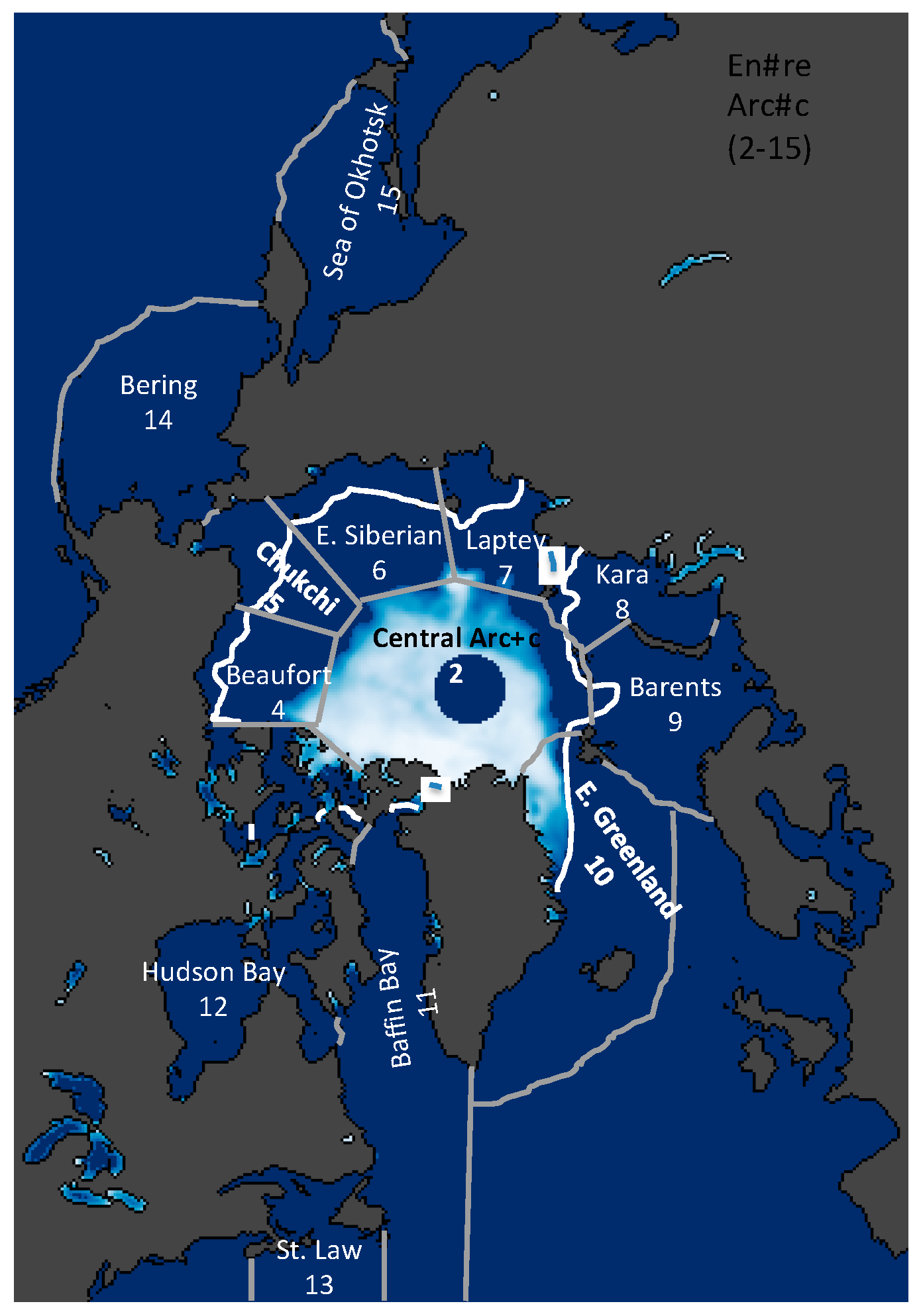
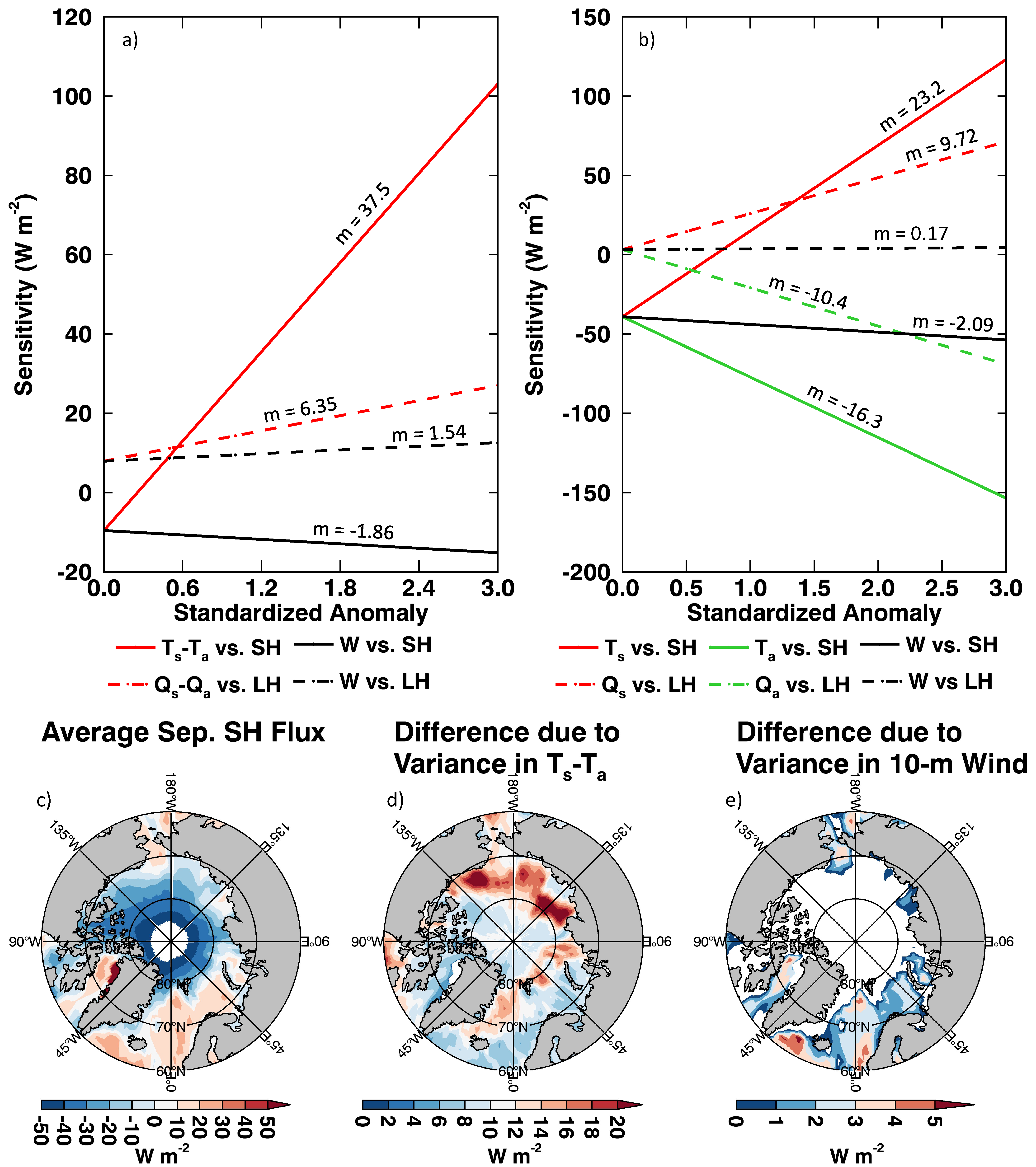

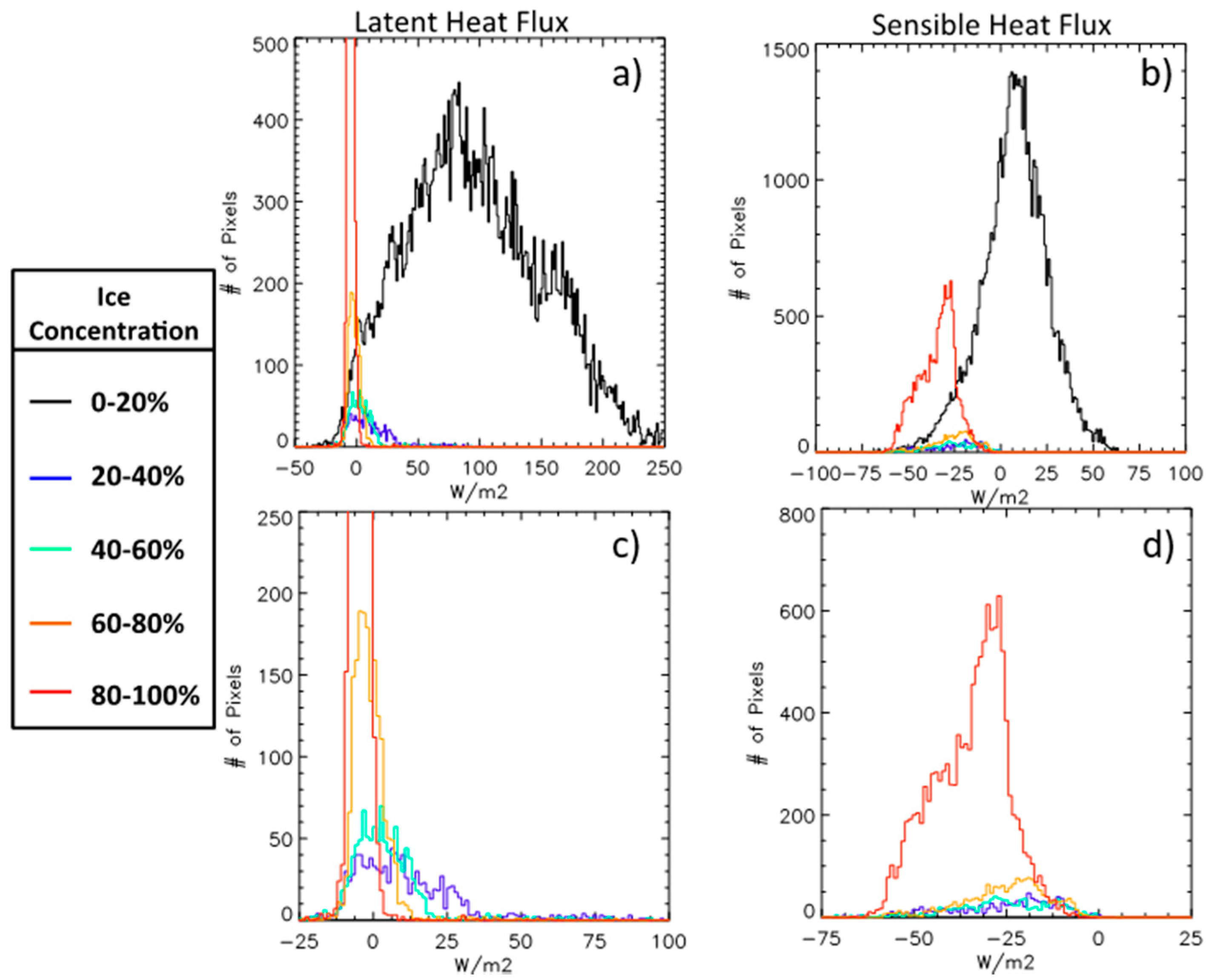
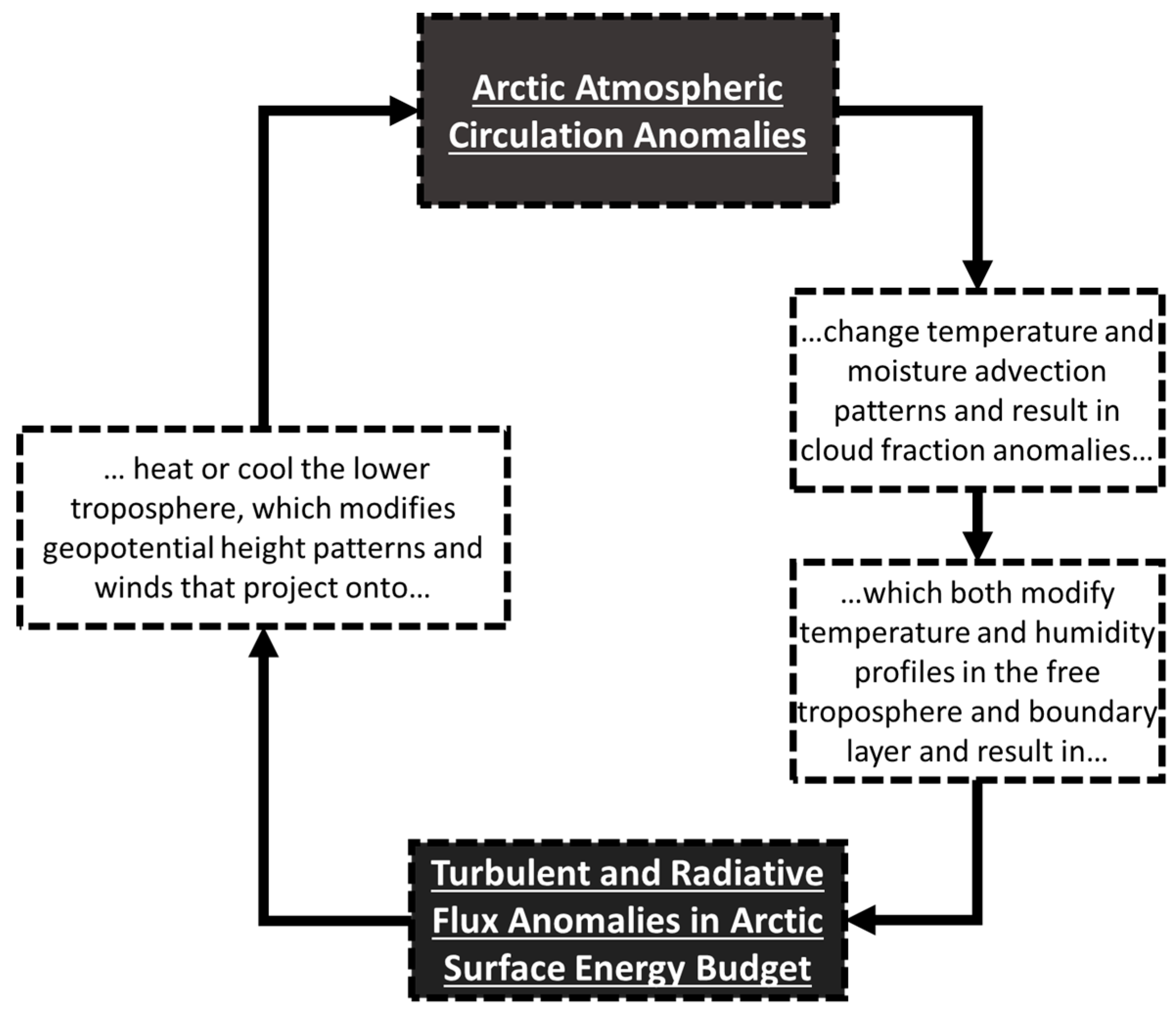
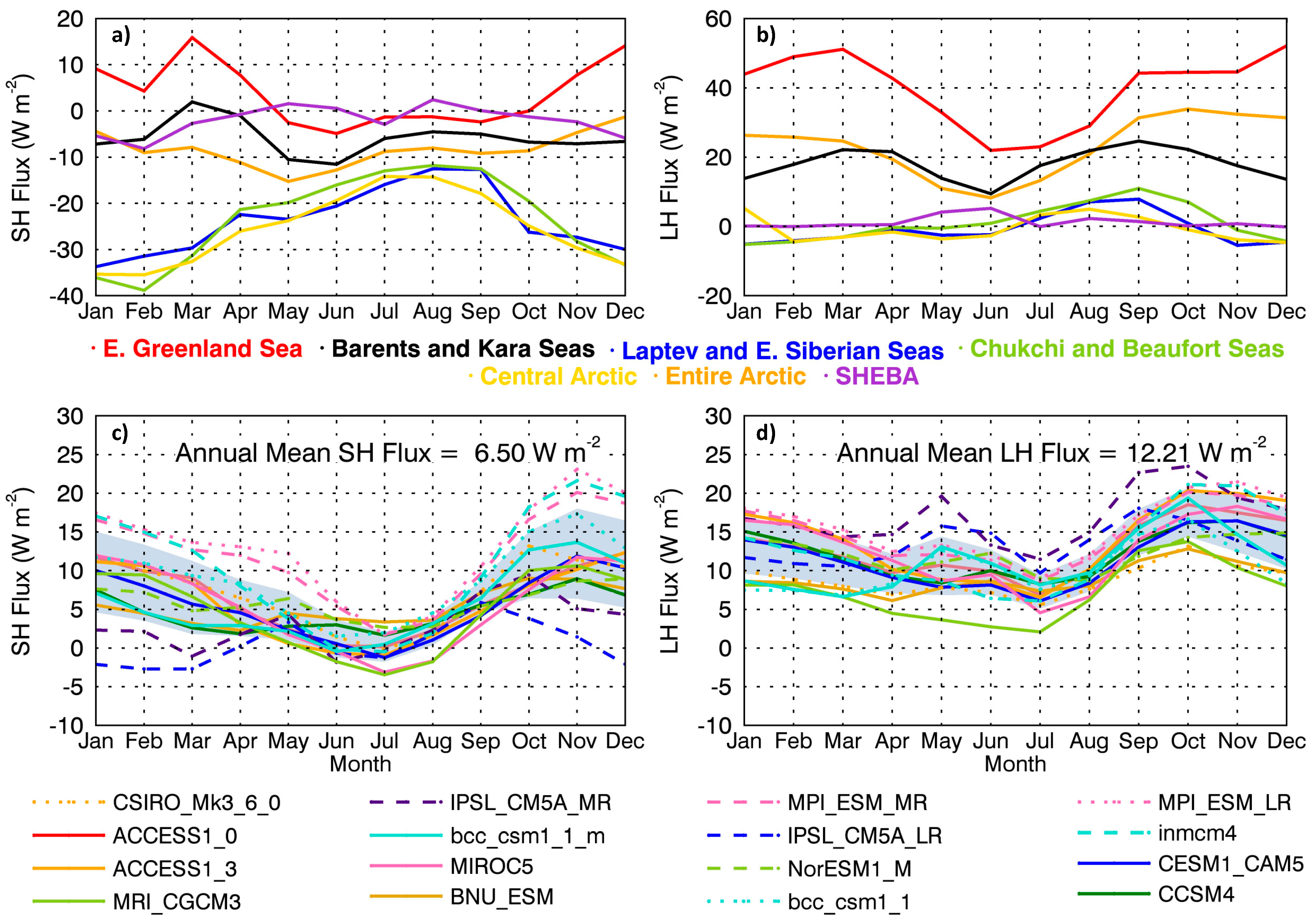
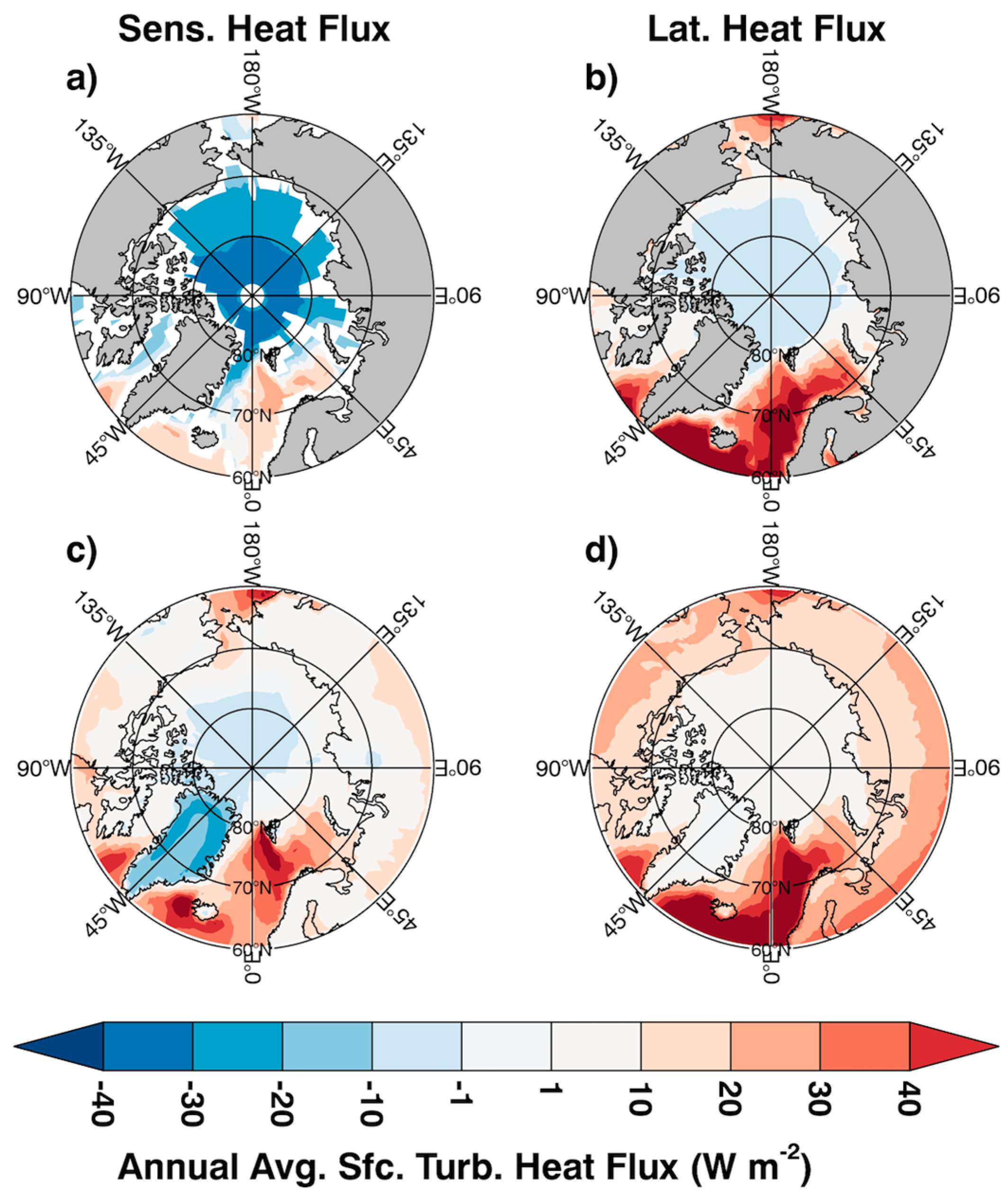
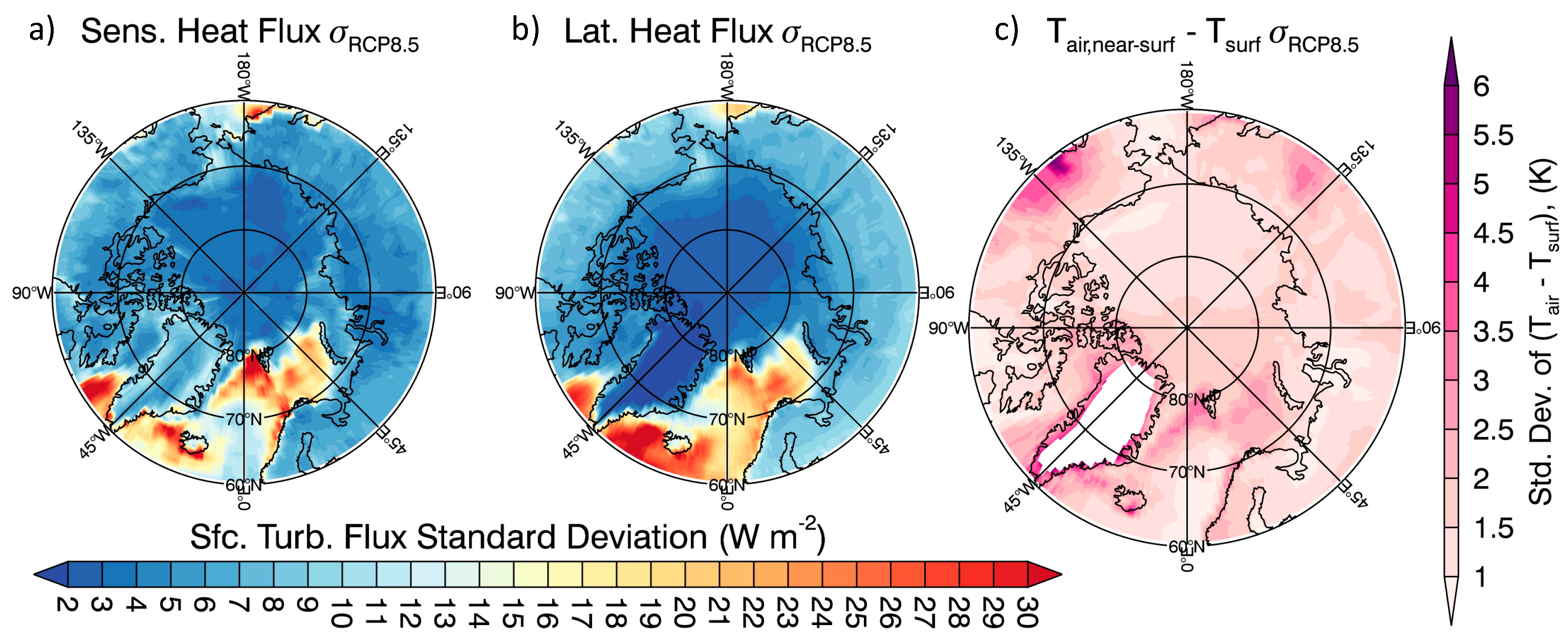

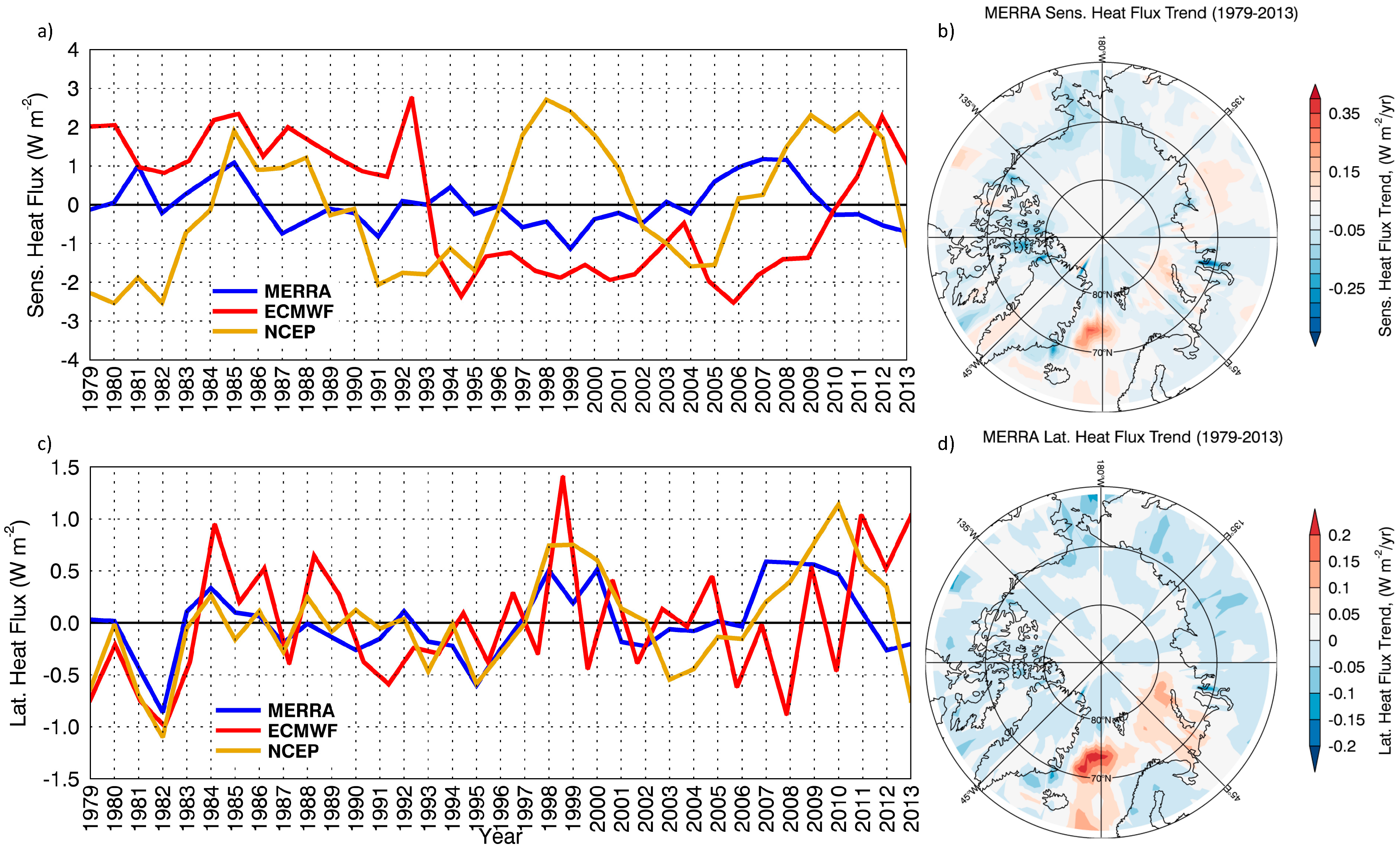
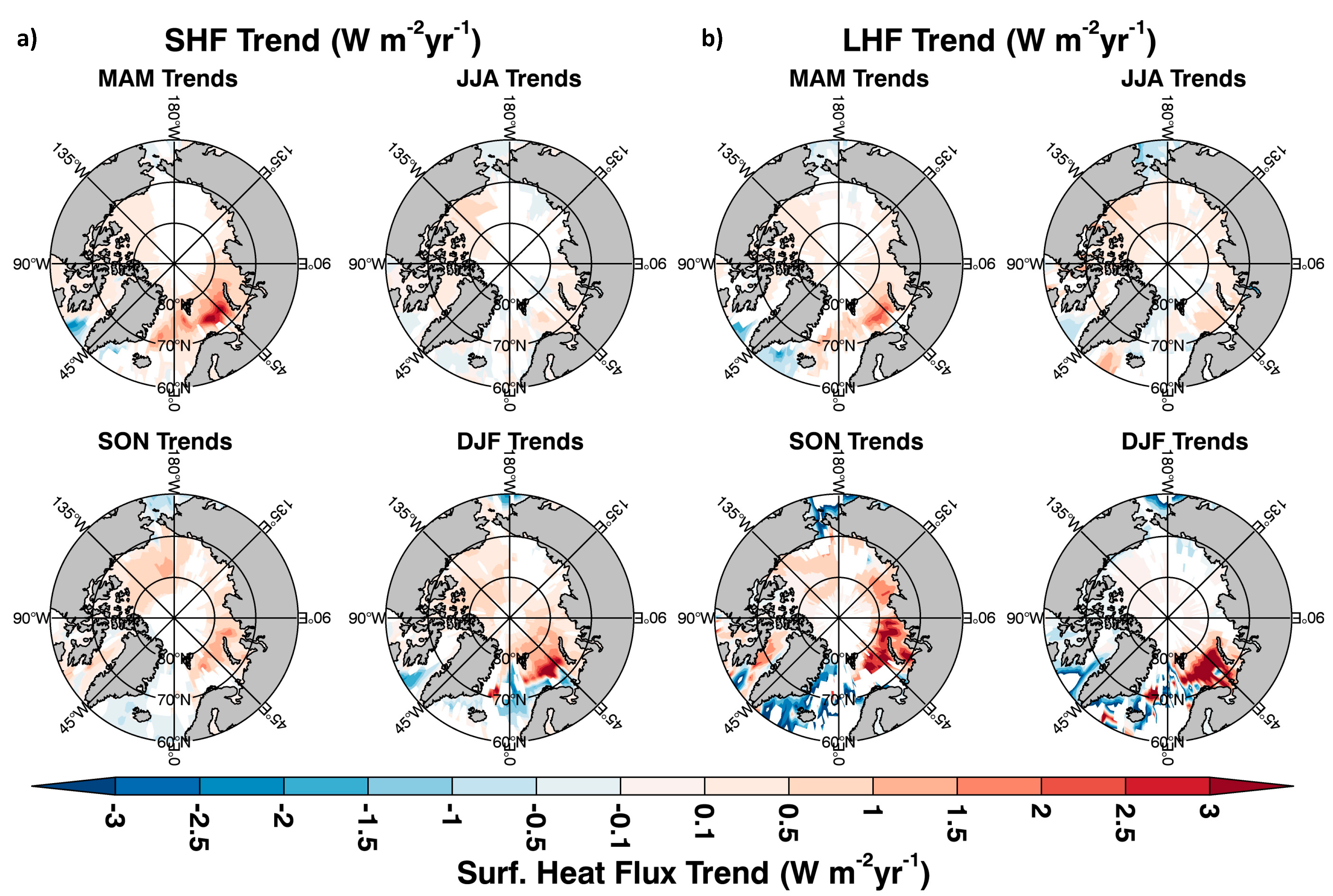
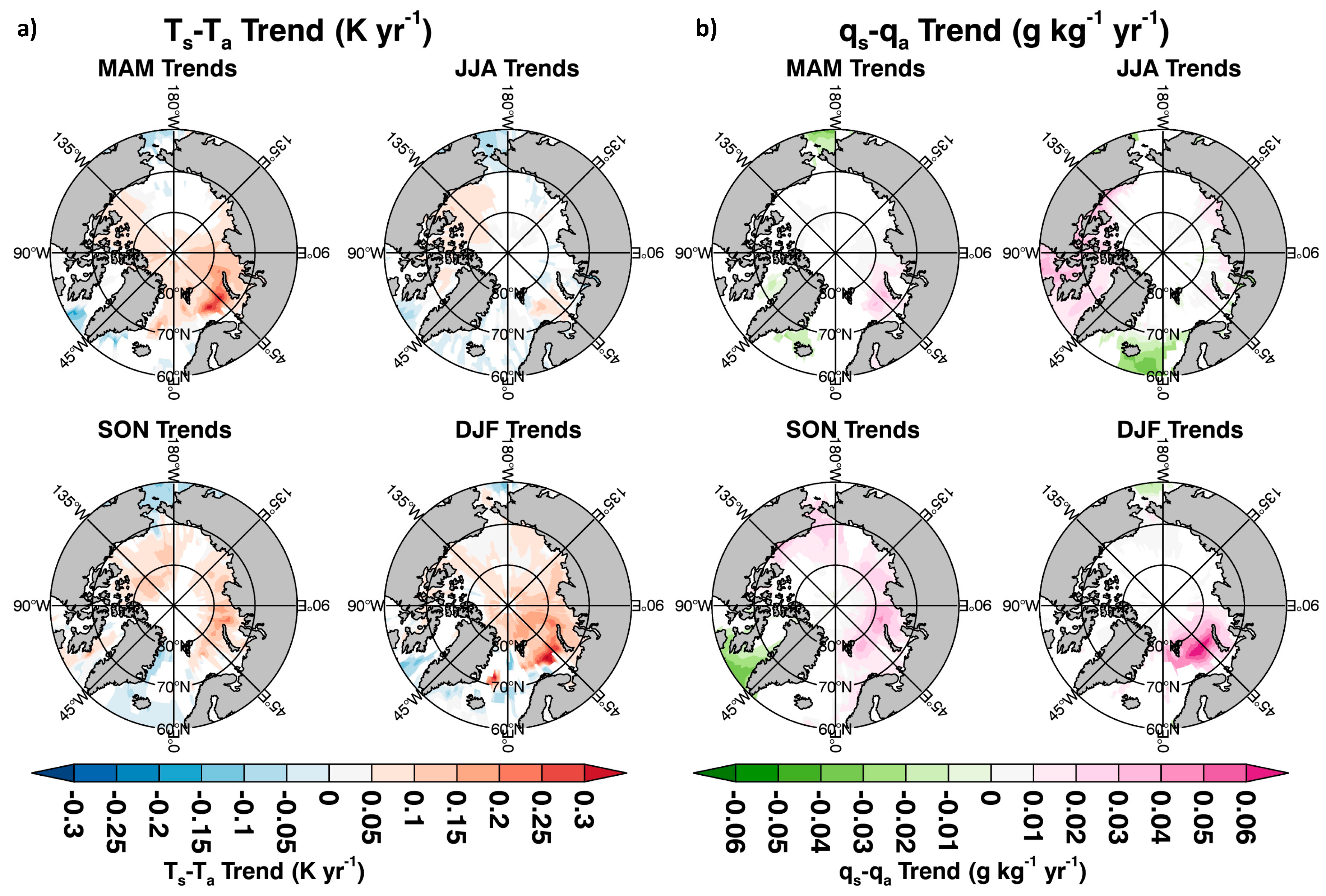

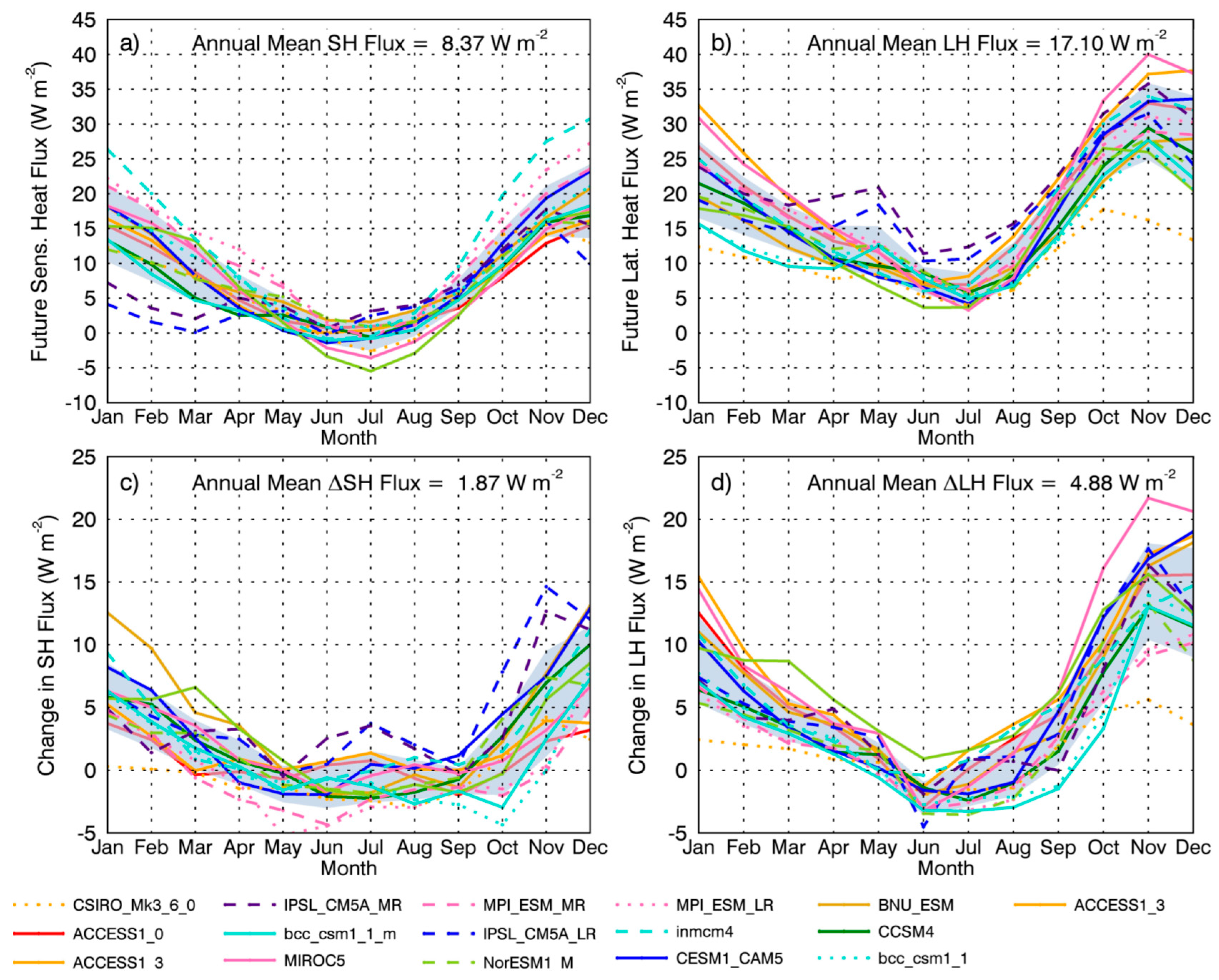
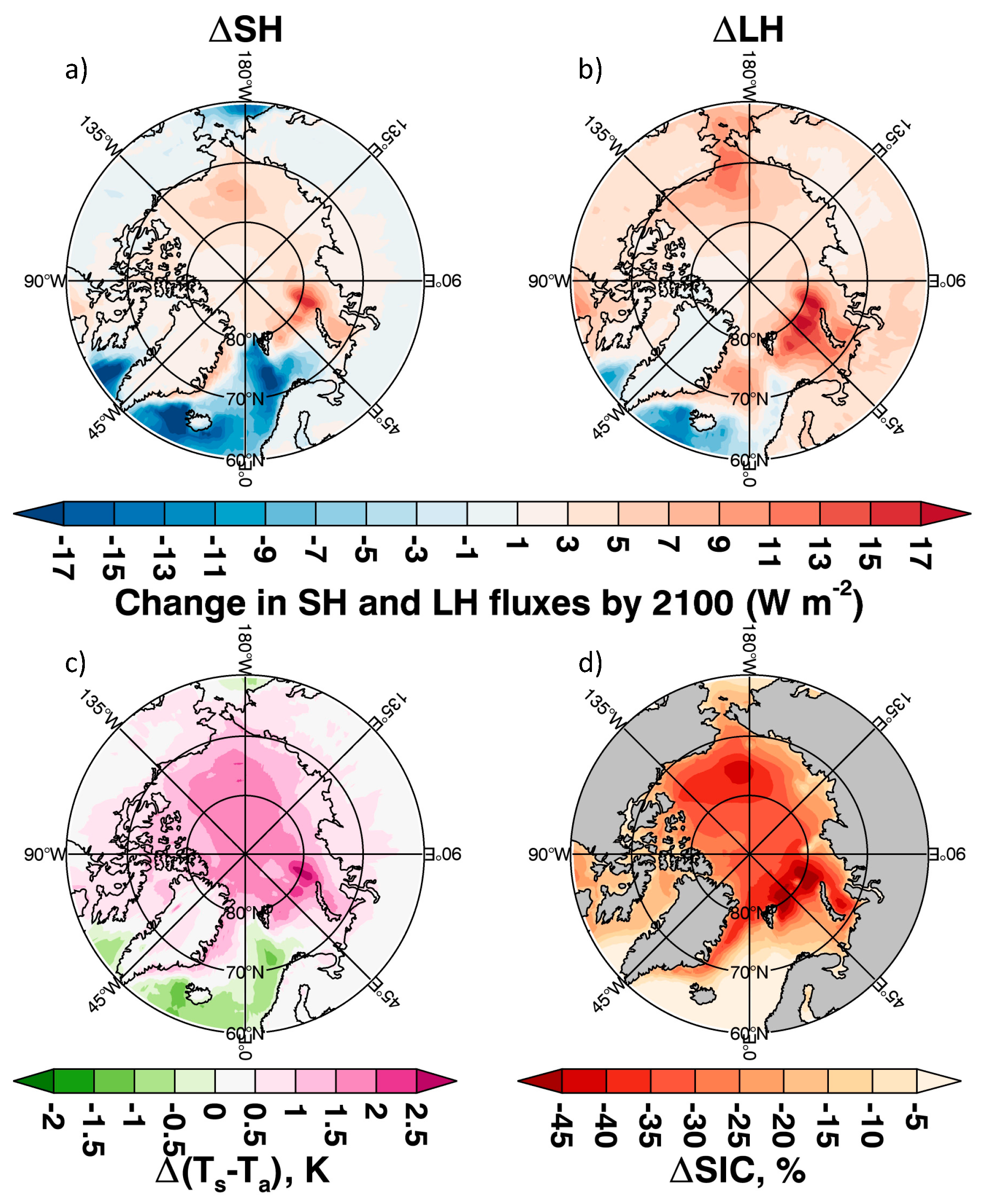
| Campaign | Duration and Location | Contribution to Understanding of Arctic Surface Processes |
|---|---|---|
| Arctic Ice Dynamics Joint Experiment (AIDJEX) | March 1975–May 1976 (main experiment). Beaufort Sea. | Early field campaign that provided in situ measurements required to calculate surface sensible heat flux in the spring and summer [95] over thick sea ice conditions. |
| Lead Experiment (LeadEx) [114] | March and April 1992. Beaufort Sea. | First coordinated field campaign measuring meteorological, surface energy budget, oceanographic, and ice measurements over multi-year sea ice and in the presence of leads in spring [114]. Measured increased sensible heat flux and increased depth of the turbulent surface layer due to the presence of leads both at the location of the lead and downwind [98]. |
| Arctic Ocean Expedition 1996 (AOE-1996) [107] | 12 July–21 September 1996. Barents and Kara Seas and central Arctic Ocean. | Provided measurements of the late-summer Central Arctic boundary layer structure and surface energy budget components, and their sensitivity to clouds and cyclonic activity in the atmosphere [9,107,115,116]. |
| Surface Heat Budget of the Arctic Ocean (SHEBA) [72,87] | October 1997–October 1998. Beaufort Sea | Only campaign to observe a full seasonal cycle. Data collected has increased understanding of seasonal cycle of surface turbulent and radiative fluxes [10] and cloud forcing [100]. Data also increased understanding of the role of the interaction of these fluxes in sea ice growth, melt, and the transitions between these states [101,102,103,117] along with assisting in developing flux-profile relationships to improve bulk surface turbulent flux calculations [88]. |
| Arctic Ocean Expedition 2001 (AOE-2001) [108] | 5 July–21 August 2001. Moored in ice floe from 2–21 August in central Arctic Ocean (main atmospheric campaign). | Expanded meteorological subprogram relative to AOE-1996. Data collected highlighted the interaction between mesoscale and synoptic-scale atmospheric variability and boundary-layer turbulence, boundary-layer structure, and surface fluxes during summer [108,118]. Data used to show frequent decoupling of low-level cloud layer from the surface and to quantify the diurnal cycle in cloud layer and near-surface parameters [118,119]. |
| Arctic Summer Cloud Ocean Study (ASCOS) [109] | 3 August–7 September 2008 Arctic Ocean north of Svalbard. | Data collected were used to examine the structures of mixed-phase low-level stratocumulus clouds coupled and uncoupled with the surface and their relationship to surface turbulent and radiative fluxes [110,111]. Data were also used to examine the co-variability of surface fluxes and sea ice freeze-up progression [58]. |
| Arctic Clouds in Summer Experiment (ACSE) [111,120] | 5 July–5 October 2014. Marginal seas north of Scandinavia and Russia, along the marginal ice zone. | Situated in the marginal ice zone in late summer and early fall, data collected showed differences in important cloud properties between the late summer and early fall. The data were also used to highlight differences in boundary layer structure over different surface types and times during the late summer and fall [111]. |
| Norwegian Young Sea-Ice Campaign (N-ICE2015) [112] | January–June 2015 Arctic Ocean north of Svalbard | Surface energy budget measurements over young, thin ice were taken during the transition from freezing to melting ice conditions, highlighting the complex relationship between clouds, winds, heat/moisture advection, and the surface ocean on surface energy components over this ice type [113,121,122]. Confirmed existence of bimodal longwave surface radiative flux distribution in January and February that also existed in SHEBA [103,123]. |
| SeaState [105] | 2 October–5 November 2015. Chukchi and Beaufort Seas. | Data collected over a sea ice formation region in autumn showed the coupling of the sea state and sea ice advance, connected through fluxes at the air-ocean-ice interface. The data also showed the importance of strong heat loss to atmosphere through surface turbulent and radiative fluxes in the sea ice formation process, especially in off-ice wind events, and the potential importance of ocean waves to sea ice formation and growth [105,106]. |
| Reference Data | RMS Error | ||
|---|---|---|---|
| AIRS V6 | ERA-Interim | ||
| Skin temperature (K): Sea Ice | Tara | 2.3 | 4.9 |
| IceBridge | 3.3 | 8.9 | |
| Skin temperature (K): Open Water | AVHRR (All) | 1.2 | 1.7 |
| 2-m Air temperature (K): Sea Ice * | 12 Ice Mass Buoys (all) | 3.41 | |
| 2009A (North Pole) | 1.00 | ||
| 2009F (Central Arctic) | 4.65 | ||
| 2010A (North Pole) | 3.69 | ||
| 2010F (Beaufort Sea) | 3.88 | ||
| 2011I (Beafort Sea) | 2.41 | ||
| 2011J (Beaufort Sea) | 3.70 | ||
| 2012H (Beaufort Sea) | 4.13 | ||
| 2013B (Central Arctic) | 3.40 | ||
| 2013F (Beaufort Sea) | 3.46 | ||
| 2013H (Central Arctic) | 3.63 | ||
| 2014I (Beaufort Sea) | 3.29 | ||
| 2015G (Central Arctic) | 3.63 | ||
| Specific Humidity (g kg−1): Sea ice | Tara | 0.55 | 0.45 |
| Specific Humidity (g kg−1): Sea ice | RV Polarstern | 0.52 | 0.31 |
| Latent Heat Flux (W m−2) | N-ICE2015 | 0.74 | |
| Sensible Heat Flux (W m−2) | N-ICE2015 | 5.32 | |
| Region | MAM | JJA | SON | DJF | Annual | |
|---|---|---|---|---|---|---|
| Entire Arctic (2–15 w/o 12 & 13) | SH | 0.39 (−17.1) | 0.063 (−10.1) | 0.15 (−8.6) | 0.37 (−21.6) | 0.22 (−16.2) |
| LH | −0.12 (19.2) | 0.002 (11.1) | 0.013 (30.8) | −0.07 (25.4) | −0.014 (17.1) | |
| Sea of Okhotsk (15) | SH | −0.17 (−3.5) | 0.15 (−8.5) | −0.15 (16.1) | 0.45 (24.7) | −0.002 (−7.0) |
| LH | −0.50 (32.0) | −0.17 (31.1) | 0.05 (79.1) | 0.56 (45.1) | −0.005 (45.9) | |
| Bering Sea (14) | SH | 0.00 (−2.8) | −0.24 (−5.1) | −0.80 (20.7) | −1.10 (20.9) | −0.47 (9.8) |
| LH | −0.93 (41.5) | −0.61 (25.7) | −1.27 (82.8) | −0.90 (67.8) | −0.74 (50.7) | |
| Baffin Bay (11) | SH | −0.35 (−6.0) | 0.008 (−9.2) | 0.53 (−12.8) | 0.13 (2.40) | 0.07 (−5.1) |
| LH | −0.83 (42.4) | −0.36 (17.5) | 0.93 (34.8) | −0.85 (55.5) | −0.16 (31.3) | |
| E. Greenland Sea (10) | SH | 0.63 (2.0) | −0.09 (−1.1) | −0.35 (4.48) | −0.03 (7.31) | 0.12 (−3.6) |
| LH | −0.16 (53.0) | −0.10 (16.5) | −0.70 (45.8) | −0.61 (58.3) | −0.30 (38.6) | |
| Barents Sea (9) | SH | 1.40 (−16.8) | 0.17 (−8.0) | 0.86 (−16.6) | 1.13 (−13.8) | 0.77 (−11.7) |
| LH | 0.98 (11.1) | 0.31 (11.0) | 0.61 (11.1) | 0.90 (10.6) | 0.66 (10.93) | |
| Kara Sea (8) | SH | 0.79 (−34.7) | 0.03 (−9.3) | 0.77 (−28.2) | 0.56 (−37.9) | 0.39 (−28.4) |
| LH | 0.31 (−2.6) | 0.18 (11.2) | 0.75 (−2.26) | 0.36 (−6.61) | 0.34 (−0.49) | |
| Laptev Sea (7) | SH | 0.49 (−31.6) | 0.12 (−14.5) | 0.44 (−27.1) | 0.33 (−37.1) | 0.27 (−28.3) |
| LH | 0.20 (−4.6) | 0.35 (0.94) | 0.47 (−4.11) | 0.08 (−5.0) | 0.23 (−3.14) | |
| E. Siberian Sea (6) | SH | 0.18 (−25.3) | −0.20 (−13.5) | 0.56 (−28.4) | 0.28 (−37.1) | 0.30 (−31.7) |
| LH | −0.08 (−0.35) | 0.22 (−2.6) | 0.31 (−1.91) | −0.002 (−5.0) | 0.12 (−2.75) | |
| Chukchi Sea (5) | SH | −0.09 (−17.4) | 0.10 (−13.5) | 0.53 (−26.7) | 0.40 (−42.0) | 0.30 (−28.5) |
| LH | −0.16 (3.2) | 0.07 (3.8) | 0.008 (10.3) | −0.03 (−4.21) | −0.01 (2.87) | |
| Beaufort Sea (4) | SH | 0.34 (−29.7) | 0.50 (−22.7) | 0.57 (−32.4) | 0.46 (−43.4) | 0.52 (−30.8) |
| LH | 0.20 (−5.6) | 0.52 (−4.5) | 0.28 (−4.86) | 0.05 (−6.0) | 0.24 (−4.84) | |
| Can. Arch. (3) | SH | 0.33 (−26.1) | 0.30 (−10.4) | 0.18 (−23.2) | 0.51 (−33.7) | 0.28 (−22.6) |
| LH | 0.22 (−5.8) | 0.53 (8.9) | 0.24 (−2.88) | 0.01 (−4.09) | 0.20 (−0.81) | |
| Central Arctic (2) | SH | 0.46 (−40.2) | 0.17 (−21.0) | 0.57 (−36.0) | 0.65 (−49.5) | 0.37 (−37.0) |
| LH | 0.16 (−8.2) | 0.20 (−9.3) | 0.23 (−10.9) | 0.15 (−7.63) | 0.15 (−8.80) |
| Model | Ts | ΔTs | Ta | ΔTa | SH | ΔSH | LH | ΔLH | SIC | ΔSIC |
|---|---|---|---|---|---|---|---|---|---|---|
| ACCESS1-0 | 262.23 | 8.94 | 263.45 | 7.82 | 6.44 | 0.73 | 12.88 | 6.22 | 42.4 | −21.8 |
| ACCESS1-3 | 262.95 | 9.10 | 264.08 | 7.94 | 5.77 | 1.65 | 13.98 | 7.64 | 41.80 | −24.50 |
| BNU-ESM | 261.19 | 9.52 | 263.34 | 8.87 | 5.28 | 4.00 | 8.97 | 6.11 | 43.3 | −22.6 |
| CCSM4 | 261.52 | 7.10 | 264.06 | 5.40 | 4.62 | 2.23 | 12.18 | 3.88 | 46.40 | −17.20 |
| CESM1-CAM5 | 260.23 | 8.59 | 262.89 | 6.96 | 5.47 | 3.25 | 11.50 | 5.83 | 46.6 | −22 |
| CSIRO-Mk3-6-0 | 257.31 | 6.22 | 259.88 | 5.07 | 7.25 | −0.36 | 8.81 | 1.55 | 51.40 | −7.00 |
| IPSL-CM5A-LR | 261.58 | 7.69 | 263.49 | 6.33 | 0.41 | 4.73 | 13.27 | 5.48 | 45.4 | −19.5 |
| IPSL-CM5A-MR | 264.27 | 6.47 | 265.71 | 5.35 | 2.97 | 3.83 | 17.03 | 4.87 | 39.70 | −17.70 |
| MIROC5 | 261.42 | 9.38 | 261.87 | 8.72 | 5.52 | 2.02 | 12.74 | 8.09 | 46.6 | −25.7 |
| MPI-ESM-MR | 263.54 | 6.53 | 264.76 | 6.49 | 11.79 | −0.45 | 14.90 | 2.92 | 42.80 | −19.00 |
| MPI-ESM-LR | 263.52 | 6.45 | 264.50 | 6.39 | 12.92 | −0.30 | 15.67 | 2.90 | 43.1 | −18.5 |
| MRI-CGCM3 | 258.44 | 7.88 | 261.44 | 5.96 | 4.71 | 2.44 | 7.23 | 7.35 | 51.30 | −18.4 |
| NorESM1-M | 260.77 | 7.47 | 262.66 | 6.77 | 5.85 | 1.94 | 12.23 | 3.46 | 47 | −17.4 |
| BCC-CSM1-1-M | 262.48 | 5.76 | 263.37 | 5.12 | 5.55 | 0.94 | 11.07 | 2.66 | 44.00 | −14 |
| BCC-CSM1-1 | 261.74 | 6.45 | 262.03 | 5.95 | 8.91 | 0.56 | 10.22 | 3.45 | 46.6 | −16.2 |
| INMCM4 | 264.13 | 5.75 | 266.29 | 4.99 | 10.52 | 2.74 | 12.74 | 5.74 | 42.90 | −18.2 |
| Ensemble Avg | 261.71 | 7.45 | 263.37 | 6.51 | 6.50 | 1.87 | 12.21 | 4.88 | 45.10 | −18.70 |
| Std Dev | 1.91 | 1.30 | 1.61 | 1.27 | 3.20 | 2.27 | 3.15 | 2.00 | 3.23 | 4.40 |
© 2018 by the authors. Licensee MDPI, Basel, Switzerland. This article is an open access article distributed under the terms and conditions of the Creative Commons Attribution (CC BY) license (http://creativecommons.org/licenses/by/4.0/).
Share and Cite
Taylor, P.C.; Hegyi, B.M.; Boeke, R.C.; Boisvert, L.N. On the Increasing Importance of Air-Sea Exchanges in a Thawing Arctic: A Review. Atmosphere 2018, 9, 41. https://doi.org/10.3390/atmos9020041
Taylor PC, Hegyi BM, Boeke RC, Boisvert LN. On the Increasing Importance of Air-Sea Exchanges in a Thawing Arctic: A Review. Atmosphere. 2018; 9(2):41. https://doi.org/10.3390/atmos9020041
Chicago/Turabian StyleTaylor, Patrick C., Bradley M. Hegyi, Robyn C. Boeke, and Linette N. Boisvert. 2018. "On the Increasing Importance of Air-Sea Exchanges in a Thawing Arctic: A Review" Atmosphere 9, no. 2: 41. https://doi.org/10.3390/atmos9020041





